A Leadership Framework for Operational Excellence and Engagement
The resource assignment matrix.
– See All Project Management Key Concepts –

A resource assignment matrix or a RAM you might see it referred to on the PMP exam, shows the project resources assigned to each work package. Each thing that we’re working on and who is working on it. It is used to illustrate the connections between work packages or activities and the project team members.
An example of a resource assignment matrix that you may be familiar with, or one of the most common ones is a RACI chart which is Responsible, Accountable, Consult (who needs to be consulted) and who needs to be Informed.
The RACI chart is a useful tool to ensure clear assignment of resource roles and responsibilities when the team consists of internal and external resources. As you can see we’ve got the activity of the Project Charter, and who’s creating that? Well Ben is Responsible for that, Anne is Accountable for that so she may need to sign off on that particular item, and we need to inform Carlos, Dina and Ed.
Then the task of collecting requirements – who’s responsible? Carlos is responsible here and Ben needs to sign off on that particular item, he is Accountable for it to make sure that it is done.
A resource assignment matrix can be developed at various levels of your work breakdown structure. In other words you can do it at a higher level, at the high level feature or you can break it down. At the high level it might define those responsibilities of the whole project or of the whole team or a group or a unit, but as we break our work down into smaller activities that we can actually estimate and deliver on, then our lower level matrix might be used within the group to designate roles responsibilities and the levels of authority within that particular work item. So it provides a lot of clarity, there’s no confusion about who is ultimately in charge or who has authority to do the work.
And that is the benefit of your resource assignment matrix.
– David McLachlan

Share this:
- Click to share on Facebook (Opens in new window)
- Click to share on Twitter (Opens in new window)
- Click to share on LinkedIn (Opens in new window)
- Click to share on Pinterest (Opens in new window)
Popular Insights:
Best Project Management Software
Mind Mapping Software
What Is a RACI Matrix?
Share this Article:
Our content and product recommendations are editorially independent. We may make money when you click links to our partners. Learn more in our Editorial & Advertising Policy .
Key takeaways
Successful project management depends on a team-wide understanding of roles and responsibilities. Using a RACI matrix to assign and define each role is a great way to keep a project on track and positioned for success.
Featured Partners
{{ POSITION }}. {{ TITLE }}
How Does a RACI Chart Help Project Managers?
Project managers use RACI charts to keep track of team roles and relay those responsibilities to the larger team. The matrix defines clear roles and responsibilities for individual team members across the various phases of the project, breaking each role down into four types of designation: those who are Responsible and Accountable for project deliverables, those who should be Consulted as work begins, and stakeholders who need to be Informed of ongoing progress, roadblocks, and updates.
Read more: Project Management Phases
RACI Matrix Definitions
Responsible.
The individual(s) with responsibility for the task or deliverable is typically responsible for developing and completing the project deliverables themselves. The responsible parties are typically hands-on team members who make direct contributions toward the completion of the project. The responsible team is comprised of the project’s “doers”, working hands-on to ensure that each deliverable is completed.
Some examples of responsible parties are:
- Project Managers
- Business Analysts
- Graphic Designers
- Copywriters
Accountable
Accountable parties ensure accountability to project deadlines, and ultimately, accountability to project completion. This group frequently also falls under the informed category.
Some examples of accountable parties are:
- Product Owners
- Signature Authorities
- Business Owners
- Key Stakeholders
Consulted individuals’ opinions are crucial, and their feedback needs to be considered at every step of the game. These individuals provide guidance that is often a prerequisite to other project tasks, for example, providing legal guidance on a project throughout the process. If you are working on new product development or expansion, this could essentially be the entire organization.
Some examples of consulted parties are:
- Legal Experts
- Information Security and Cybersecurity Experts
- Compliance Consultants
Informed persons are those that need to stay in the loop of communication throughout the project. These individuals do not have to be consulted or be a part of the decision-making, but they should be made aware of all project updates. Typically, this party are business owners or stakeholders that are more interested in viewing the project at a 30,000-foot view. Keep this group on your cc list for awareness of topics, decisions, and progress – that includes making them part of the initial project kickoff and project demos as optional attendees. This group often also falls under the accountable group.
Some examples of informed parties are:
- Project Committee Members
- External Stakeholders
Read more: DACI vs RACI Model Guide
Why Are RACI Roles Important?
RACI roles provide a sense of organization and clarity for teams that are looking to divide roles and keep team members accountable for their contributions. Considering that 27% of projects go over budget, for reasons like scope creep and lack of defined roles, RACI roles help position a project for success and avoid common pitfalls.
Moreover, RACI roles help ensure that communication between all roles is ongoing. When you consider that nearly half of all project spending is at risk of being wasted due to a lack of effective team-based communication, it becomes all that more important to prioritize. Ultimately, teams who prioritize communication and well-defined roles are better off, and RACI roles help teams achieve that goal faster – while providing accountability for each team member’s unique contributions to the success of the project.
Read More: Top 10 Main Causes of Project Failure
How to Create a RACI Matrix
If you’re looking to implement a RACI matrix as part of your team’s project planning process, take these steps to create a RACI matrix.
Ensure that you have a thorough understanding of the project and its demands before outlining any further steps by communicating with key stakeholders and decision-makers.
Determine the list of key activities and deliverables from the director of program management or other leadership.
Determine who is needed to be a part of the project or initiative.
Determine the project roles and responsible job titles and persons for each activity and deliverable.
Hold review sessions with key members of the team for alignment, and if you haven’t already, host a kickoff meeting with the entirety of the team and key stakeholders to unveil the matrix, address questions, and more.
If the project has already started, it’s not too late to implement a RACI matrix.
- Outline the story. Using research from multiple sources, do a, b, c, and d.
- Utilize steps 2 and 3 (shown above). Ensure the right groups are assigned and engaged.
- Hold a review session. Ensure that the team acknowledges and discusses the plan and the roles assigned.
Read more: 8 Factors That Lead to Successful Projec ts
Examples of a RACI Matrix

As shown above, a RACI matrix helps break down what roles individuals will play as work is carried out and to what extent they will be involved in the project overall. The horizontal axis represents each person on the project team and the vertical axis represents each task.
Each square of the matrix represents an individual, a task, and that individual’s role within the project, either responsible, accountable, consulted, or informed. In this situation, for example, the project manager is accountable for accessing risk, defining performance requirements, creating designs, executing construction, and approving construction work. However, they are only informed about approving construction work and defining functional and aesthetic needs.
Read more: Understanding Different Types of Stakeholders and Their Roles
Our FREE Downloadable RACI Matrix Template
Who creates the raci matrix.
The RACI matrix — sometimes called RACI model, RACI diagram, or simply just RAC — is created by the project manager at the start of the project as a key part of establishing the initial human resources planning for the project. Because miscommunication is a common threat to any project, RACI charts are a great asset to teams dealing with any type of project, from very simple projects to extremely complex ones.
Common Mistakes When Creating a RACI Matrix
- Failure to plan ahead: Utilizing a RACI matrix should not be your first step in project planning. Having a fully assembled project team and at least a general idea of a task list and project plans is a better place to start before preparing a matrix.
- Working with too large a team: A RACI matrix is likely not the best bet for a large team, as it will make the matrix hard to understand and overly complex.
- Not communicating with the project team: A RACI matrix should help organize tasks and responsibilities that have already been introduced to the project team – no one likes to be blindsided. Be sure to host a kickoff meeting with the team first before creating a RACI matrix.
Frequently Asked Questions
Implementing a RACI matrix takes more than just a few emails and sporadic conversations – it takes consistent communication and planning. You should host a kickoff meeting to introduce the matrix to the team and make a plan to continue meeting at predetermined times throughout the project lifecycle.
Here are a few more tips to keep in mind as you implement your RACI matrix within the team dynamic:
- Get everyone prepared. Send the document around to the meeting distribution as read-ahead material, requesting feedback if there are any major concerns.
- Roll out each role for the team . During the meeting, conduct a review of the tasks and responsible parties. Do not rush through this review, but rather ensure enough time in your project kickoff for this important aspect. (Be certain to clarify the definitions of RACI to avoid ambiguity.)
- Consider changes and update accordingly. After the meeting, send out the notes documenting acceptance or updates to the RACI. In addition to sending out the notes, request any corrections within a reasonable yet defined timeframe. Clarify that if no changes are requested, each person is acknowledging their role and committing to the project tasks as outlined.
- Stay in touch. Consider a quick review with the entire team each quarter or every six months for longer projects to ensure it remains up-to-date and not simply another document in the repository but a relied-upon artifact.
As you implement the RACI matrix…
- Encourage teamwork and foster collaboration whenever possible.
- Don’t fear updates – make changes and adjustments as needed (but be sure to communicate those changes clearly to all parties).
- Earlier is better. Roll out your matrix plan to the team BEFORE you plan to implement it for the best results.
- Have a clear-cut understanding of the project scope and how each role connects to the overall project goal.
For “Responsible” Parties:
- Make sure your project’s definition of Responsible is clear on who holds the “decider” role for the project or project phase’s completion, and what the dimensions of that responsibility will be.
- Ensure that all parties are aware of their role and responsibilities within the matrix.
For “Accountable” Parties:
- When multiple Accountable team members must exist, use your definitions to make clear which individual is accountable for a given project element, and how that individual needs to interact with other Accountable team members.
- Ensure that there is only one “Accountable” party assigned per task.
- Be sure that the Accountable party has the authority and power to oversee the task as the accountable party.
For Consulted and Informed Parties:
- Consulted parties are often high-level decision-makers with heavy schedules. Make sure you’re clear on their availability ahead of time.
- Similar to Consulted parties, Informed parties are often less hands-on and have less understanding of day-to-day project operations. As the project goes on, make sure to keep detailed notes to keep the Informed party up-to-date on key information.
- Understand the ways that these parties like to communicate and create a plan to reach them early – whether that’s over phone calls, emails, video calls, or from within your project management system’s collaboration tools.
- Knowing the difference between who needs to be consulted versus informed can be a challenge if there is ambiguity about project roles. Consider what aspects of the project different team members need to know to do their jobs, and then bake those into your definitions.
RACI Matrix Pros & Cons
- Increased Engagement: RACI helps engage project participants in the project lifecycle.
- Enhanced Project Planning: Project managers make project planning more organized, efficient, and detailed.
- Identifiable Improvement Opportunities: Areas of improvement are more easily identified.
- Easier Collaboration: Use of a RACI matrix creates a clear path for leadership to sign off on project steps, as project documentation in the RACI model is heavily emphasized.
- Better Communication: Improves overall group communication as a whole.
- Group Accountability: Assists groups, especially larger project teams, stay connected and accountable to their roles and project goals
- Limitations on Role Scope: The RACI model does not provide details on role scope, especially for responsible parties. These gaps in detail also affect other team roles, for example, another gap in a RACI is the determination of who is responsible for verifier and signatory.
- Limits on Task Details and Scope: While a RACI matrix can provide an overview of who is responsible for different tasks, it will not state what needs to be done.
- Not Aligned to the Agile Methodology: Project managers using an agile methodology like scrum may find it redundant since accountability, ownership, and ongoing communication is built into the scrum framework (i.e., product owner, scrum master, and daily standups with the team). Additionally, agile focuses on team-based delivery and accountability, while the RACI framework and alternatives focus on individual responsibility and autonomous accountability.
Read more: Top 10 Causes of Project Failure
Free RACI Matrix Templates
A number of project management software solutions include a native RACI matrix template. Here are just a few we’ve found:
Colorful RACI Chart Template
We love this template from Smartsheet because it’s colorful, thorough, and includes room for every party involved in the project.

Pastel Colored RACI Matrix Template
This template from the Academy to Innovate HR is a great choice for project managers who want to organize their team roles with an easy-on-the-eyes chart that evolves beyond the simple spreadsheet.

Simple RACI Chart from Clickup
These RACI templates from Clickup have enough variety to fit any of your project needs, but are simple enough for even beginner PMs to use.

Detailed RACI Matrix Template
This template is a great starter template for anyone looking to explore RACI charts in their project management strategy . As an added bonus – it comes with the RACI definitions already built in!

Excel-Based RACI Chart Template
Are you an Excel or Google Sheets user looking to take advantage of the RACI matrix? An Excel-formatted template from Project Management Docs can be just the solution for you. This template is a great template for users who want a chart that comes in a pre-formatted structure.

Sign up for our emails and be the first to see helpful how-tos, insider tips & tricks, and a collection of templates & tools. Subscribe Now
{{ TITLE }}
You should also read.

What Is a Critical Path Method in Project Management?

How to Take Meeting Minutes Effectively (+ Example and Templates)

How to Manage Time Constraints: Top 7 Expert Tips
Join our newsletter.
Subscribe to Project Management Insider for best practices, reviews and resources.
By clicking the button you agree of the privacy policy

Get the Newsletter
You might also like.
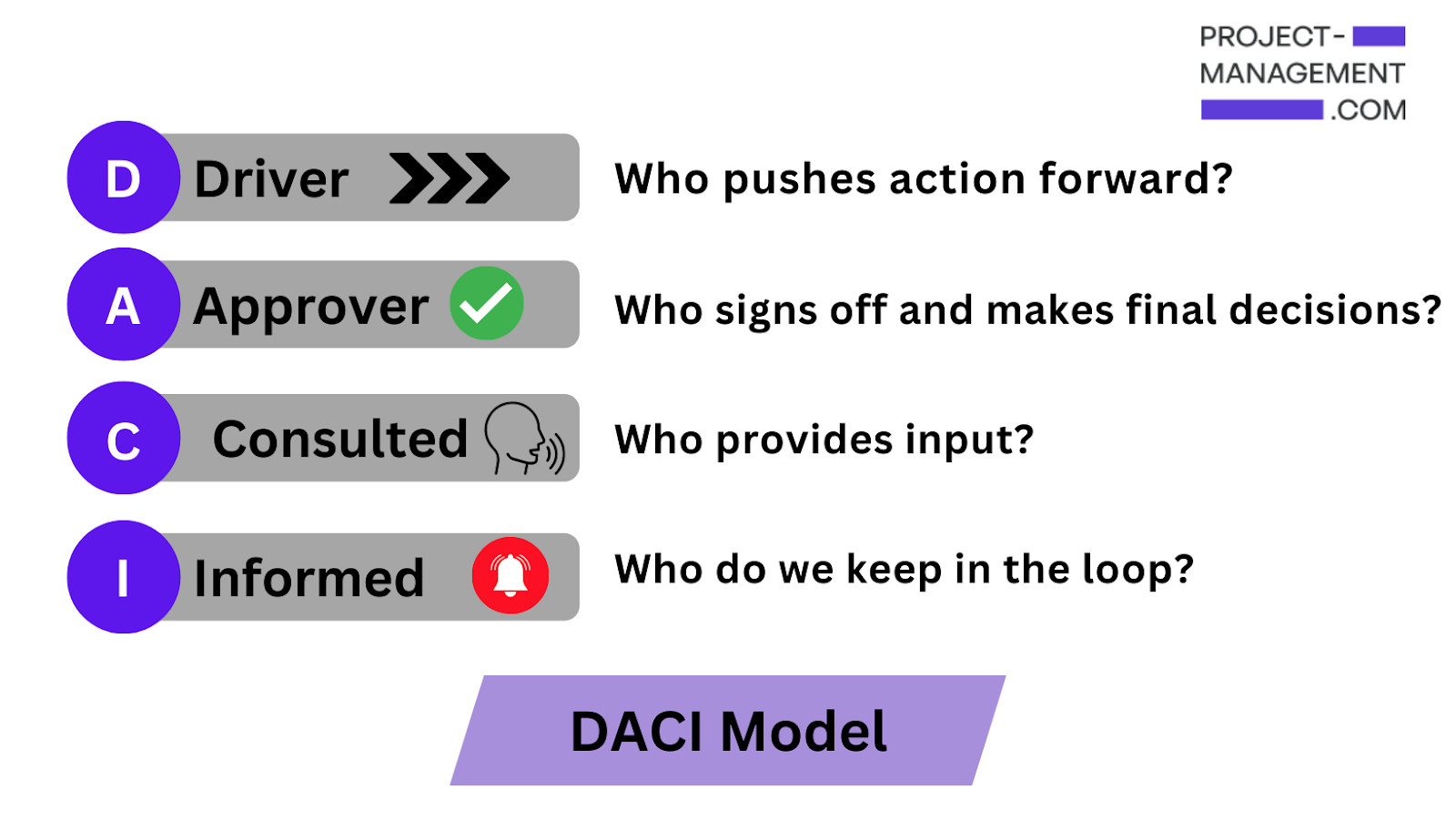
6 RACI Matrix Alternatives to Help Define Project Roles
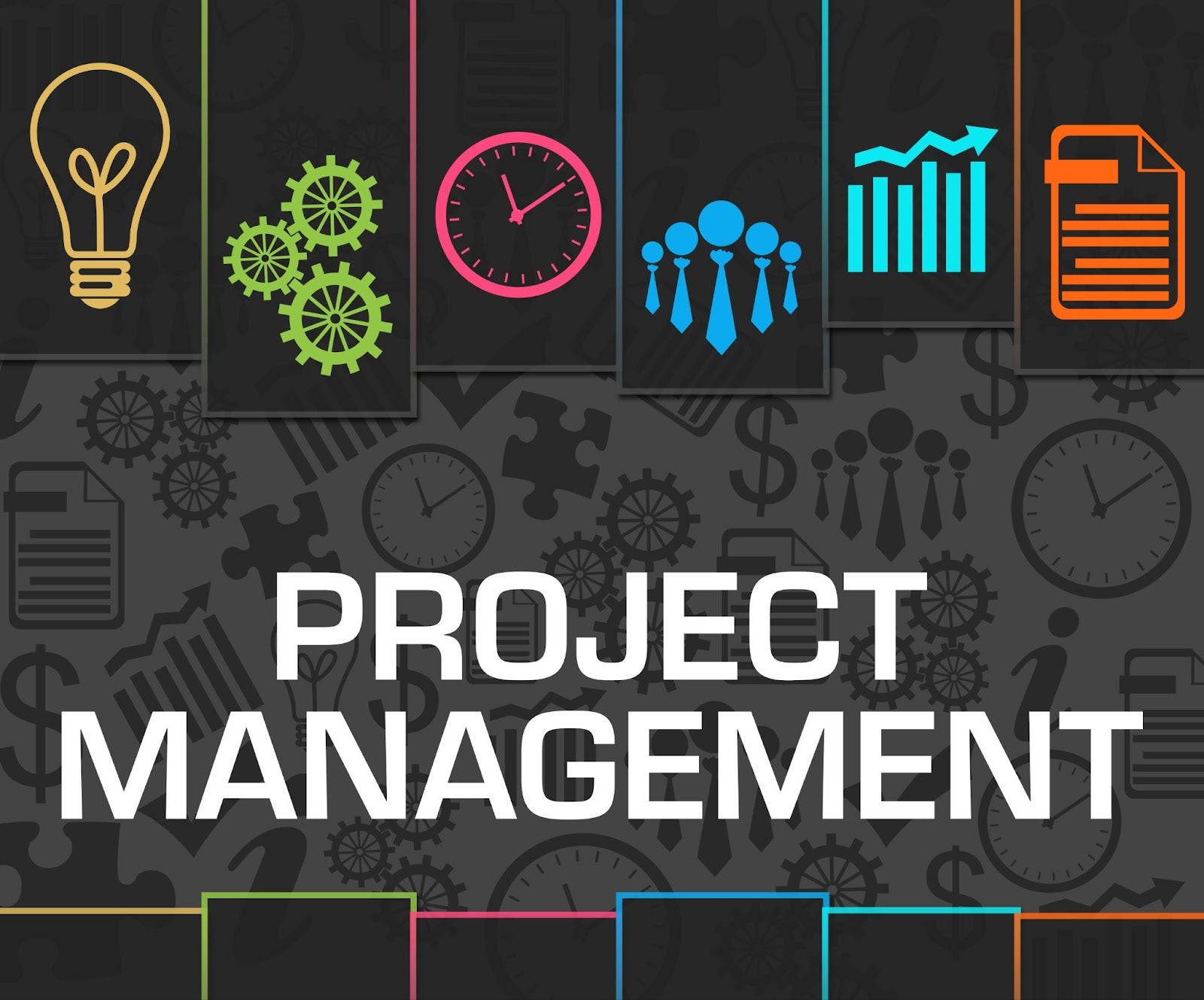
10 Benefits of Project Management Software for Business

Risk Identification Techniques and Methods for Projects

What is a Responsibility Assignment Matrix (RAM) in Project Management?
- 1. Project Management Basics
- 2. Project Management Methodologies
- 3. Project Management Life Cycle
- 4. Best Project Management Software
- 5. Team Collaboration Tips
- 6. Agile Methodology Basics
- 7. Agile Project Management Tools & Techniques
- 8. Project Management Frameworks
- 9. Resources
- 10. Glossary
- Advanced Terminology
- Methodologies
- PM Software Features
- Basic Terminology
- Professional Development
- Agile Project Management
Introduction to Responsibility Assignment Matrix (RAM)
Project management is a complex process that involves multiple stakeholders, tasks, and resources. To ensure the success of a project, it is crucial to assign clear roles and responsibilities to team members and accurately define their tasks.
One tool that can help project managers achieve this goal is the Responsibility Assignment Matrix (RAM). In this article, we will explore the definition and benefits of RAM, as well as some examples.
If you’re looking for a RAM template that will help you assign roles and clarify responsibilities, Wrike has a customizable template ready to go.
What is a Responsibility Assignment Matrix (RAM) in project management?
A responsibility assignment matrix (RAM) in project management, also known as a RACI chart or RACI matrix, details all the necessary stakeholders and clarifies responsibilities amongst cross-functional teams and their involvement level in a project. RACI stands for Responsible, Accountable, Consulted, and Informed and each letter corresponds to a team member.
A RAM in project management should be referred to by all parties throughout a project because it helps plan an individual’s roles and responsibilities before work begins. A RACI matrix ensures all stakeholders know who is responsible for completing a task or getting feedback on deliverables.
The four roles are broken down as follows:
- Responsible: The person(s) completing the task
- Accountable: The team member coordinating the actions, making decisions, and delegating to those responsible for the task
- Consulted: The person(s) who will be communicated with regarding decisions and tasks
- Informed: The person(s) who will be updated during the project and upon completion
Read more about RACI here .
Identify and visualize roles seamlessly with Wrike
Responsibility assignment matrix example.
A common RAM template looks like the example below. Notice how all stakeholders can have more than one role:
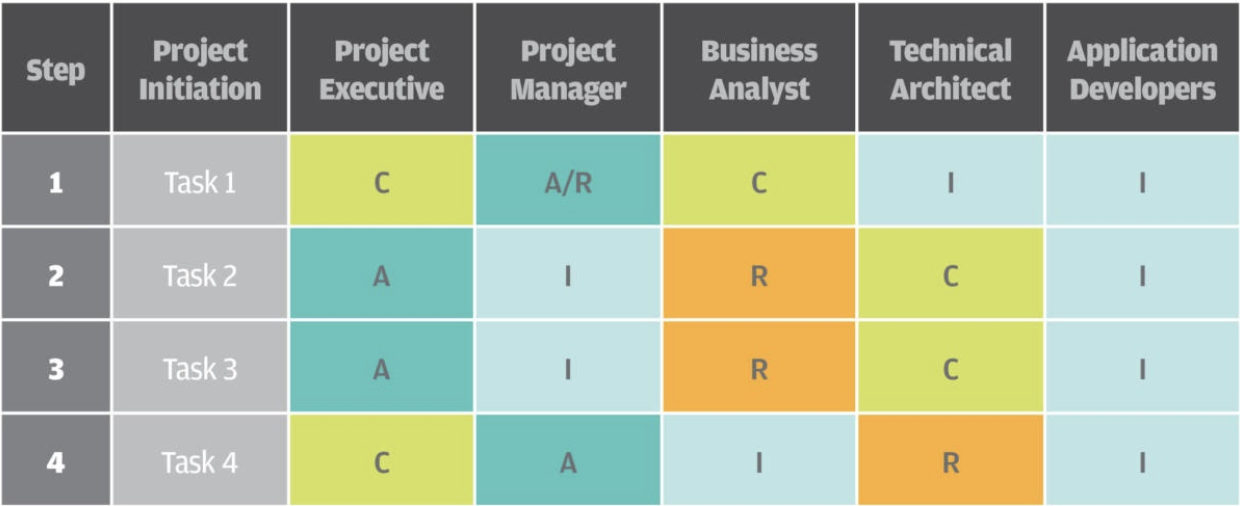
Responsibility Assignment Matrix template
Below you can see a powerful RAM template . The chart helps with visualizing roles and workload clearly. Therefore, project managers and team members follow the progress easily and stay on track.
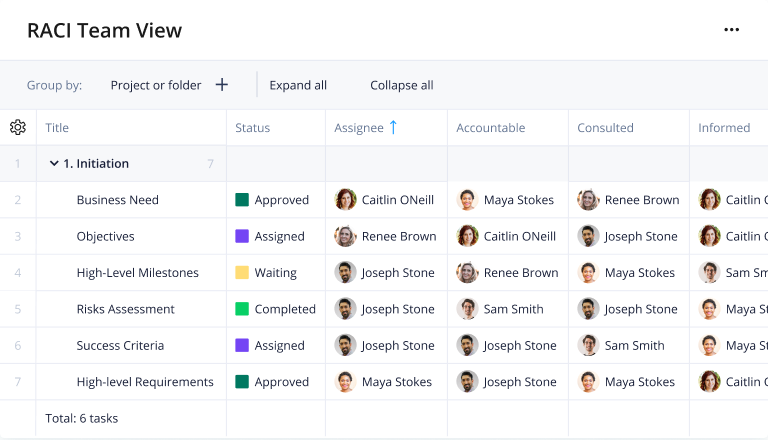
Clarify roles with Wrike
In conclusion, RAM is a useful tool for any project manager who wants to ensure their team is clear on their responsibilities. It helps to establish a structured approach to project management, allowing for better communication, accountability, and ultimately, project success.
Using Wrike’s pre-built template, you can define the roles of each team member so everybody is on the same page. The template will also help you balance your workload and create complete transparency on your team structure.
What is a RACI Chart?
Basic Project Management
- Project Charter
- Project Management Stakeholders
- What is a Project?
- Work Breakdown Structure
- Project Objectives
- Project Baseline
- Project Management Scheduling
- Project Management Work Packages
- Project Management Scope
- Scope Creep
Advanced Project Management
- What is PERT?
- Network Diagram
- Risk Management
- Cost Estimation
- Feasibility Study
- Monte Carlo Analysis
- Project Integration
- Cost Management
- PMI Project Management
- What To Do With Certification
- Certification
- Become Certified
- PMP Certification
- Best Certification
Software Features
- Critical Success Factors
- Capacity Planning
- User Role Access Permissions
- Time Tracking
- Budget Tracking
- Request Forms
- Work Assignments
- Version Control
- Dependency Managements
- Project management Milestones
- Project Management Software
- Project Management Tools
- Project Management System
- Gantt Charts
.css-s5s6ko{margin-right:42px;color:#F5F4F3;}@media (max-width: 1120px){.css-s5s6ko{margin-right:12px;}} Discover how today’s most successful IT leaders stand out from the rest. .css-1ixh9fn{display:inline-block;}@media (max-width: 480px){.css-1ixh9fn{display:block;margin-top:12px;}} .css-1uaoevr-heading-6{font-size:14px;line-height:24px;font-weight:500;-webkit-text-decoration:underline;text-decoration:underline;color:#F5F4F3;}.css-1uaoevr-heading-6:hover{color:#F5F4F3;} .css-ora5nu-heading-6{display:-webkit-box;display:-webkit-flex;display:-ms-flexbox;display:flex;-webkit-align-items:center;-webkit-box-align:center;-ms-flex-align:center;align-items:center;-webkit-box-pack:start;-ms-flex-pack:start;-webkit-justify-content:flex-start;justify-content:flex-start;color:#0D0E10;-webkit-transition:all 0.3s;transition:all 0.3s;position:relative;font-size:16px;line-height:28px;padding:0;font-size:14px;line-height:24px;font-weight:500;-webkit-text-decoration:underline;text-decoration:underline;color:#F5F4F3;}.css-ora5nu-heading-6:hover{border-bottom:0;color:#CD4848;}.css-ora5nu-heading-6:hover path{fill:#CD4848;}.css-ora5nu-heading-6:hover div{border-color:#CD4848;}.css-ora5nu-heading-6:hover div:before{border-left-color:#CD4848;}.css-ora5nu-heading-6:active{border-bottom:0;background-color:#EBE8E8;color:#0D0E10;}.css-ora5nu-heading-6:active path{fill:#0D0E10;}.css-ora5nu-heading-6:active div{border-color:#0D0E10;}.css-ora5nu-heading-6:active div:before{border-left-color:#0D0E10;}.css-ora5nu-heading-6:hover{color:#F5F4F3;} Read the report .css-1k6cidy{width:11px;height:11px;margin-left:8px;}.css-1k6cidy path{fill:currentColor;}
- Project management |
Your guide to RACI charts, with examples

Can you identify exactly who’s doing what by when for each task, milestone, and deliverable in your project? If not, you might need a RACI chart.
RACI is an acronym to help teams clarify project roles and figure out who the responsible party is for any given task. Whether you've never heard of RACI before or you’re considering creating a RACI chart for your next project, here’s everything you need to know about how to create and use these charts.
What is a RACI chart?
Responsible. This person is directly in charge of the work. There should only ever be one Responsible role per task so you know who to go to with questions or updates. If a task has more than one Responsible person, you can lose clarity and cause confusion. Instead, aim to add additional collaborators as some of the other RACI roles, which can have more than one person.
Accountable. The Accountable person is responsible for overseeing overall task completion, though they may not be the person actually doing the work. There are two ways to assign an Accountable role. Sometimes, the Accountable is the project manager (or even the Responsible, though in that case the person is taking on two different roles during the task workflow). In these cases, the Accountable is responsible for making sure all of the work gets done. In other cases, the Accountable is a senior leader or executive who is responsible for approving the work before it’s considered complete. Like the Responsible role, there should only ever be one Accountable.
Consulted. This will be the person or people who should review and sign off on the work before it’s delivered. There may be multiple Consulted roles for each task, project milestone , or deliverable.
Informed. This is the person or group of people who are informed about the progress and completion of work. They probably are not involved in any other aspect of the deliverable.
When should I create RACI charts?
RACI charts are a helpful way to track each stakeholder’s role for a task, milestone, or deliverable—especially if you’re managing a complex project with many decision makers and subject matter experts. With a RACI chart, you can prevent poor decision making and avoid roadblocks in the approvals process that could impact overall project success.
These charts, while different from PERT charts , are especially useful if your stakeholders may be taking on different roles throughout the project. For example, there could be a stakeholder who is Responsible on one deliverable but Informed on another. With a RACI chart, you can clearly outline these details and make sure everyone knows who’s responsible for what.
Example of a RACI chart
To build a RACI chart, list every task, milestone, or deliverable for your project. Then, identify who the Responsible, Accountable, Consulted, and Informed team members are for each one.
Let’s say you’re updating the homepage on your website. Project stakeholders include:
Head of website
Web developer
You want to create a RACI chart for five tasks and deliverables:
Update homepage CTAs
Update customer story on homepage
Revamp website design
Improve homepage loading speed
Update homepage design
The RACI chart would look like:
Responsible: Copywriter
Accountable: Web developer
Consulted: Head of website
Informed: Designer
Revamp video on homepage
Responsible: Designer
Informed: Copywriter
Responsible: Web developer
Informed: Copywriter & Designer
Pros and cons of RACI charts
Ultimately, the question is: should you create a RACI chart? While RACI charts are a useful tool to identify project responsibilities, they can get a little cumbersome over the lifecycle of a project. Here are the pros and cons of creating a RACI chart for your team’s work:
The benefits of RACI charts
Clear project roles and responsibilities can help your team move fast and reduce confusion about who’s working on what. With a RACI chart, you can ensure you don’t have two team members working on the same thing. As a result, you’ll have an easier time collaborating with your team.
RACI charts are also particularly helpful when the decision-making process is split between tasks. There might be scenarios where the Informed on one task or milestone is the Responsible or Consulted on another—in order to have that clearly defined, it’s helpful to track this work in a RACI chart.
RACI chart pitfalls (and how to avoid them)
RACI models focus on the granular, instead of capturing work at the project level. You might know who the Consulted is on a particular task—which is helpful—but knowing that doesn’t help you understand how various stakeholders interact with the broader project work.
Additionally, if you attempt to write out each task and each role, your RACI chart can get bulky. Worse, if your project changes in some way, your RACI chart would immediately become outdated. That can make it hard for you to gain real-time clarity about where each task is in your project workflow.
RACI charts are limited because they aren’t able to adapt to your project needs in real time. In order to establish clear expectations and eliminate confusion on the project level, you need a project management tool .
Take your RACI chart to the next level
With project management software, every task has an assignee—that’s the Responsible. You can see work on the project level, so the Accountable and Informed don’t have to check in via email or status meetings. And, for any approvals you need from your Consulted, you can track reviews and approvals in one place. That way, your entire RACI team has a central source of truth for all of the work being done.
![what is resource assignment matrix [Product UI] Brand campaign RACI chart (Lists)](https://assets.asana.biz/transform/f8cc1f69-97b6-4806-9471-b27453e459a9/inline-generic-list-2x?io=transform:fill,width:2560&format=webp)
Instead of having your RACI chart separate from where the work is happening, project management tools capture the topic, assignee, and other important information like the task due date or relative importance. That way, your entire project team has visibility into who’s doing what by when—and you’re not relying on a single person to manage and update your RACI chart. Project management tools update in real time, so you can see exactly where you are in the approval process.
Track who’s doing what by when
Clear team roles and responsibilities help you hit your deliverables on time. Tracking different and complex stakeholder responsibilities in a RACI chart can help you do that—but RACI charts are just the beginning. Learn more about work management , and how your team can benefit.
Related resources

How Asana uses work management to optimize resource planning

Understanding dependencies in project management

Program manager vs. project manager: Key differences to know

Critical path method: How to use CPM for project management
- Contact sales
- Start free trial
Resource Planning
This guide to resource plans is brought to you by projectmanager, the project management software trusted by 35,000+ users. build a resource plan in minutes.

What Is Resource Planning?
Resource plan key terms, stages of a resource plan, what is resource management software, desktop vs. online resource management software, benefits of online resource management software, must-have features of resource management software.
- Execute a Resource Plan in ProjectManager
- Creating a Resource Management Plan
Resource Management Best Practices
Resource planning organizes, identifies and lists the resources required to complete a project successfully. Resources are assets that are required to execute a project; a resource is a broad category and includes equipment, tools, supplies, materials, time and people.
A proper resource plan will map out the exact quantities of the necessary storable resources (such as cash) and non-storable resources (like machinery or labor). Considerations made during resource planning factor greatly into the scheduling and budgeting of projects.
Related: 25 Free Project Management Templates for Excel
Because it’s so important to align your resources with your budget and your project schedule, it’s best to use a project planning software to get everything organized in one tool. ProjectManager makes it easy to manage resources, budgets and project schedules in one online platform.

What Are The Components of a Resource Plan?
A resource plan aims to use resources in the most efficient manner possible, thus contributing to the overall productivity of the project. This is furthered by properly allocating your project team where their skill set will take the project the farthest. The best bet is to have a constant flow of resources and make sure you’re using them wisely and productively.
When resource planning, you should ask yourself the following questions about the most key components:
- What are the roles of the project team?
- What are the procurement needs of the project?
- What types of contracts are required?
- Are there any pre-qualification methods needed?
- What criteria will be used to select contractors or vendors?
- How much of the budget is allocated to resources?
- How will performance be measured in the project?
- What policies and procedures will be used?
To better understand how to manage your resources in projects, we should first break down different key terms that are often associated with resource management .
Remember, resources are more than just your team—they’re also your equipment, assets and office space. They’re everything, in fact, that has a cost required to complete the project.
- Resource Plan: A detailed list of resources and the ways you will manage them throughout the project. The more detailed, the better.
- Resources Breakdown Structure (RBS): A resources breakdown structure creates hierarchies of resources, according to the hiring organization (like a reporting structure or team hierarchy) or by geography (such as all the teams or equipment required in Asia or Africa). Include all resources on which the project funds will be spent, but it’s up to you to define which type of hierarchies are relevant to your project. Its execution is similar to a WBS.
- Responsibility Assignment Matrix: A responsibility assignment matrix defines resources according to various levels of responsibility for completing project tasks or for the overall project. Clarify the roles and responsibilities of the entire project.
- Resource Overallocation: Overallocation simply means when a person is given too much work, which can impact the budget and even derail a project. It’s crucial that resources are balanced, so you’re going to need a way to stay on top of your team’s workload throughout the life cycle of the project.
- Resources Histogram: This provides a visual of the resources for anyone in the project who needs to stay in the loop. It’s a quick and easy way to view the allocation of your resources and note whether any are over- or under-allocated.
- Resource Dependency: This refers to a theory that an organization should guard against having all their eggs in one team basket. That is, over-reliance on one team to accomplish core work (especially if it’s an external team) can lead to workload blocks and resource shortages.
- Resource Leveling: Leveling resources is a juggling act, whereby you manage resource availability across a project or across multiple projects. It can be accomplished by extending the duration you had planned for certain tasks to be accomplished by adjusting the start and end dates, depending on whether you have the resources to complete them now or not.
Related: Free Resource Plan Template
There are four main stages to resource planning one should follow to ensure your bottom line stays firm and you are able to get the available resources when you need them. This is also called the resource management life cycle .
Before the project starts, begin to figure out the resources you’ll need to execute it. This includes the budget for those resources to make sure your project is profitable, and getting sign off from stakeholders. To start this process, the project resource requirements must first be decided upon. Then, you can think of filling the types and amount of roles that will be required.
1. Ascertain Resources
After you’ve evaluated the situation and determined what the objectives of the project are, you have to select the right strategy and estimate the resources that you’ll need to reach that goal. Resource forecasting must be thought through as efficiently and cost-effectively as possible. These resources include labor, materials, equipment, facilities and others, such as admin, subcontractors, etc.
2. Procure Resources
You need to start to assemble your team according to the skills and experience the project requires. Equipment must be sourced, and contractors secured. Some of the aspects of this stage of resource planning include developing team roles, procurement needs, contracts, budgets, measurements to judge performance and any policies and resource optimization procedures.
3. Manage Resources
At this point, you need to define the roles and responsibilities of your team, who is doing what. Subcontractors’ roles also need to be defined. If you’re using tools and equipment that is being rented for the project, then you must make sure they’re returned in a condition that meets the requirements of the contract. Any facilities must be maintained, too.
There will be issues, of course, and when they occur you have to identify, define, investigate and analyze, solve and then review.
4. Control Resources
Somewhat different from managing resources is controlling your resources, which means monitoring the resources during execution to make sure they’re delivering the results that are expected of them. What this boils down to is something called the resource utilization rate, which measures how efficiently you use the resources.
If the utilization rate is too low, action must be taken, such as a cost-benefit analysis . You should always be evaluating outcomes to make sure you stay on track.
Resource management software is a tool that assists in the planning and scheduling of projects. It’s used to manage your team, tools, equipment, materials and so forth—all of which are crucial to your success.

Your resources all have costs associated with them, and are often used for a limited period. These expenses and timeframes must be managed to align with the schedule. Resource management software lets you plan with these resources in mind, then allows you to allocate them and track who’s working on what and when.
A resource management tool will help you track costs and time related to your resources in order to make sure you use them as planned and are sticking to the project budget. Microsoft Project is one of the most commonly used project management software, but it has major drawbacks that make ProjectManager better for resource management.
Desktop and online resource management software share many features. This can make it difficult to choose which is the right solution for your project. They both allow managers a high-level view of the project resources. This makes it easier to quickly view the resources needed and provide just the right amount.
You can also generate reports with both a desktop and online application. For example, project status reports are critical to make sure you’re not overspending. They’re also a communication vehicle to present to project stakeholders and keep them updated on progress.
Pros of Desktop Resource Management Software
There are big differences between the two, however, and if you’re looking for security and speed, the desktop model might be best. Desktop applications can be more secure if they don’t require an internet connection. Of course, neither desktop or online software are guaranteed to offer impenetrable security, but the desktop probably does have an edge there.
Speed is also a factor. Desktops are not at the mercy of the strength of your online connection. Of course, if your internet connection is severed, then your online tool will not function at all.
Pros of Online Resource Management Software
While desktop software might have advantages in security and speed, those gaps are rapidly closing. Advancements in two-factor authentication and Single Sign On can provide an incredibly secure experience.
Online has other advantages that desktops can never achieve. The major difference is that an online resource management tool is going to have real-time data, which is crucial when managing resources to keep the project running smoothly.
Real-time data means better decision making, but it also creates a platform on which your team can collaborate. This leads to greater productivity, meaning your resources will go further. Having features that connect teams to work through their tasks together helps with efficiency and building better teams.
Finally, an online resource management software can be accessed anywhere and at any time, if there’s online connectivity. That means teams that are distributed across the globe have access to the tool and can even work together. It also means that all your project documentation is centrally located and also available when and where you need it.
Managing resources requires real-time data to keep track of your costs and the time spent in order to maintain your budget and stay on schedule.
Online resource management software gives relevant and timely information because you don’t have the luxury of waiting when the success of your project hangs in the balance. But that’s not all you get, the following are more advantages related to using an online resource management tool:
- Track resource costs
- View availability of team
- Balance team’s workload
- Integrate resources into project plan
- Automatic calculation of actual vs. planned costs
- Keep updated on team’s hours with automatic timesheets
There are lots of resource management software options on the market. To choose the one that is best for your project, make sure it has these features:
Assign Teams & Track Resources
When building your project plan, schedules must include team assignments and the related resources they’ll need to execute their tasks. Interactive Gantt charts do all this online, giving you a tool to assign and track project resources that stay on budget and deliver on time.
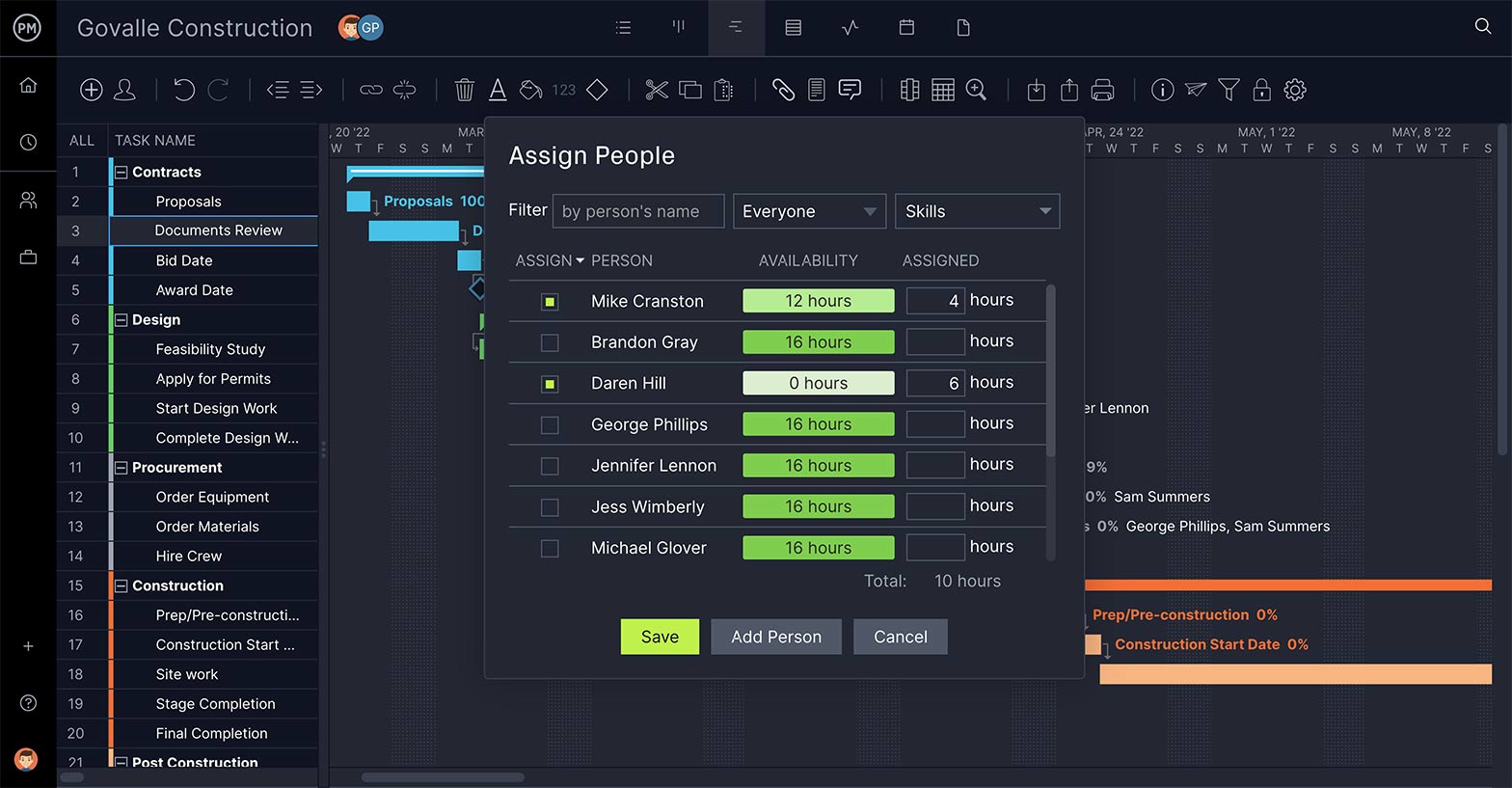
Track Your Team’s Work
Timesheets have become more than a tool for payroll. Resource management tools can have timesheets that automatically reflect your team’s status updates. This not only streamlines the process, but gives managers an invaluable view into their team’s progress.
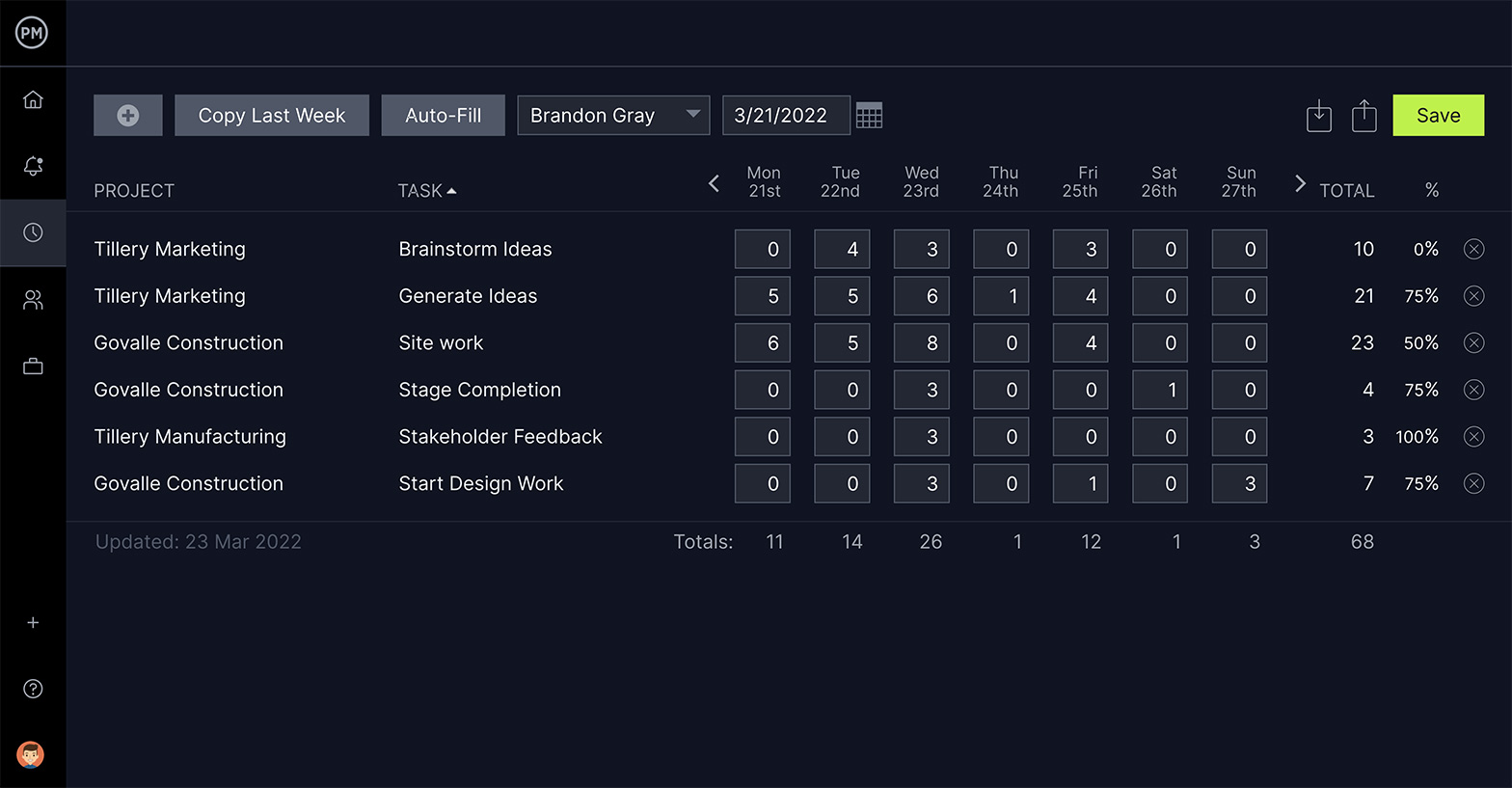
Know Who’s Working on What
To keep teams working productively, you need to know how many tasks they’ve been assigned. Having a view into their workload can help you re-allocate as needed to make sure they’re not overburdened. Balancing workload also makes sure your resources are being used efficiently.

Keep Updated With Live Information
An online resource management tool collects live data to help managers make better decisions. But you also need a system in place to keep managers and their teams aware of any updates. A tool that triggers email alerts is a must, one that has in-app notifications is essential.
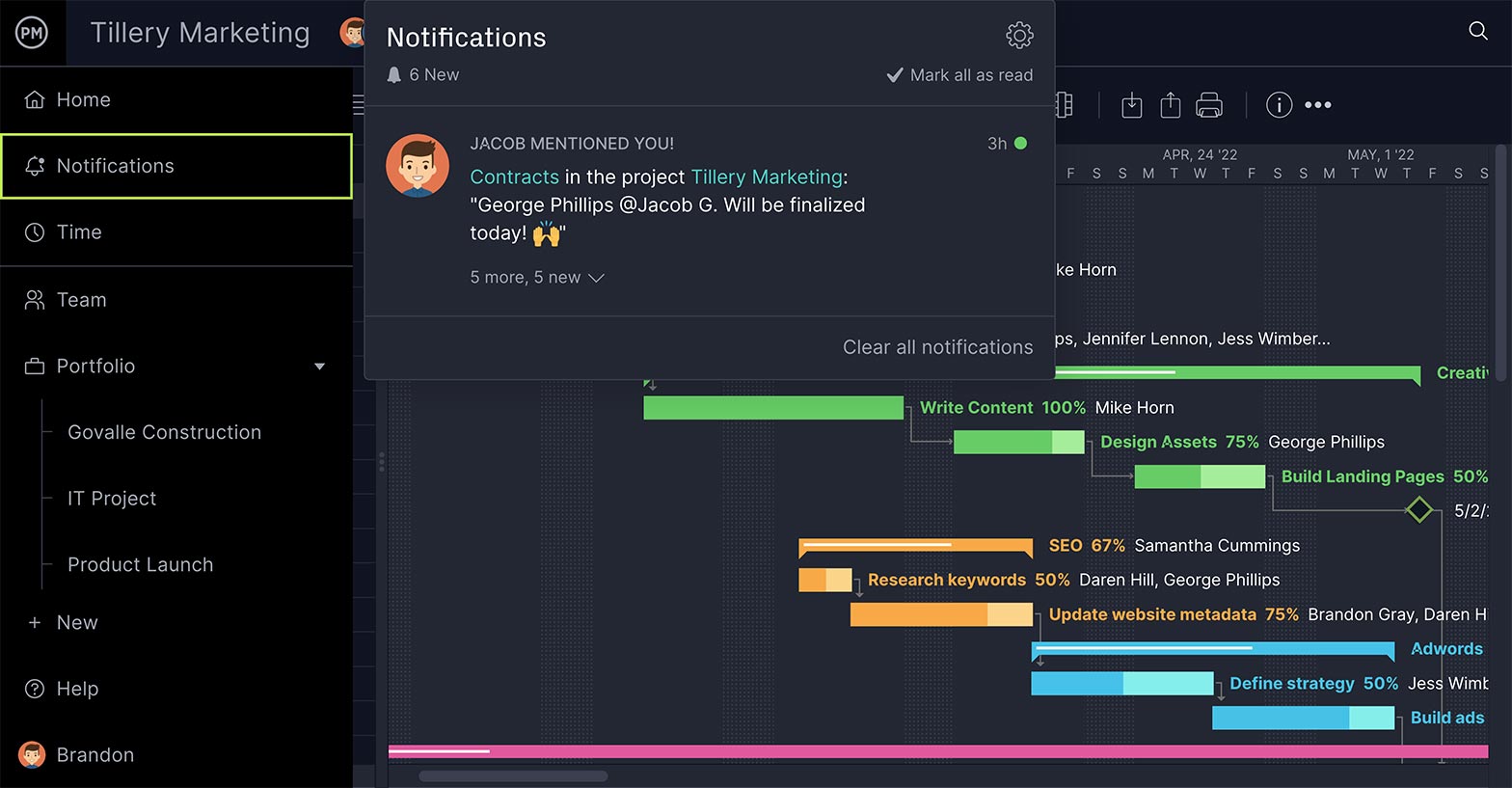
Get Easy, Flexible & Detailed Data
Reporting features collect data on the progress and performance of your project and give you insights into how to best manage your resources. Having a report that can be easily shared with stakeholders and filtered to focus in on specifics is ideal.

See Resources Across Many Projects
Managers are often responsible for more than one project, such as a program or portfolio, and want a tool that can assign, track and report on all their projects. This allows you to find synergy between projects and have them all work together for greater efficiency.
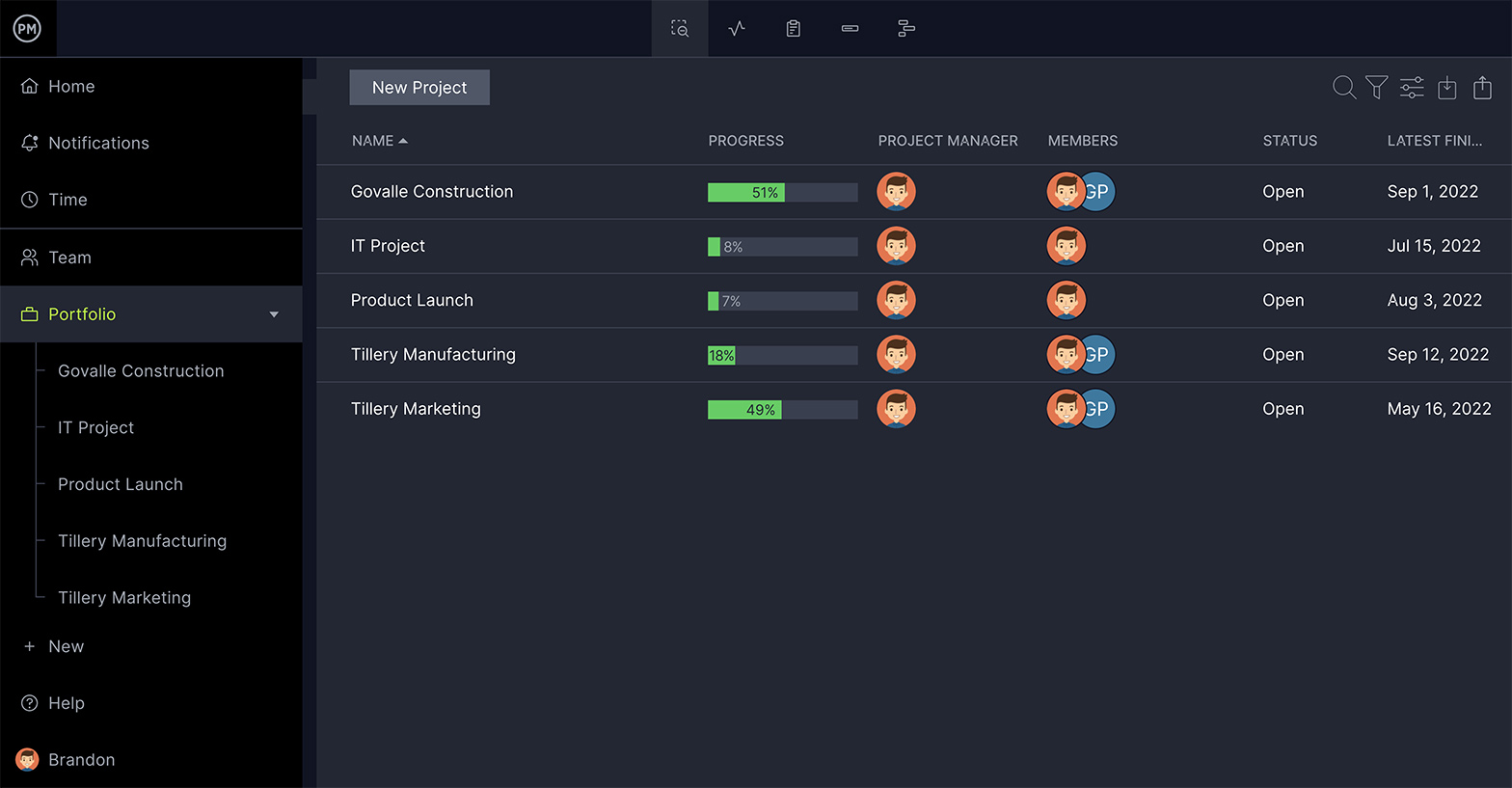
How to Execute a Resource Plan in ProjectManager
Resource management software assists project managers with planning and scheduling their project resources. It’s usually included as part of a suite of project management features that are designed to manage every aspect of your project.
ProjectManager is an award-winning software that’s designed to identify, organize and monitor your resources with robust online Gantt charts, real-time dashboards and one-click reporting that let you stay on top of everything. Here’s how it works:
1. List All Your Tasks
Gathering all the necessary tasks and determining the level of effort for a project is the first step needed to define your resources. You need to know what you’re doing before you can determine what you’ll need to do it!
Collect all your tasks on the task list view or Gantt chart view in our software. Add estimated start and end dates to populate the project timeline on the right side of the Gantt chart.
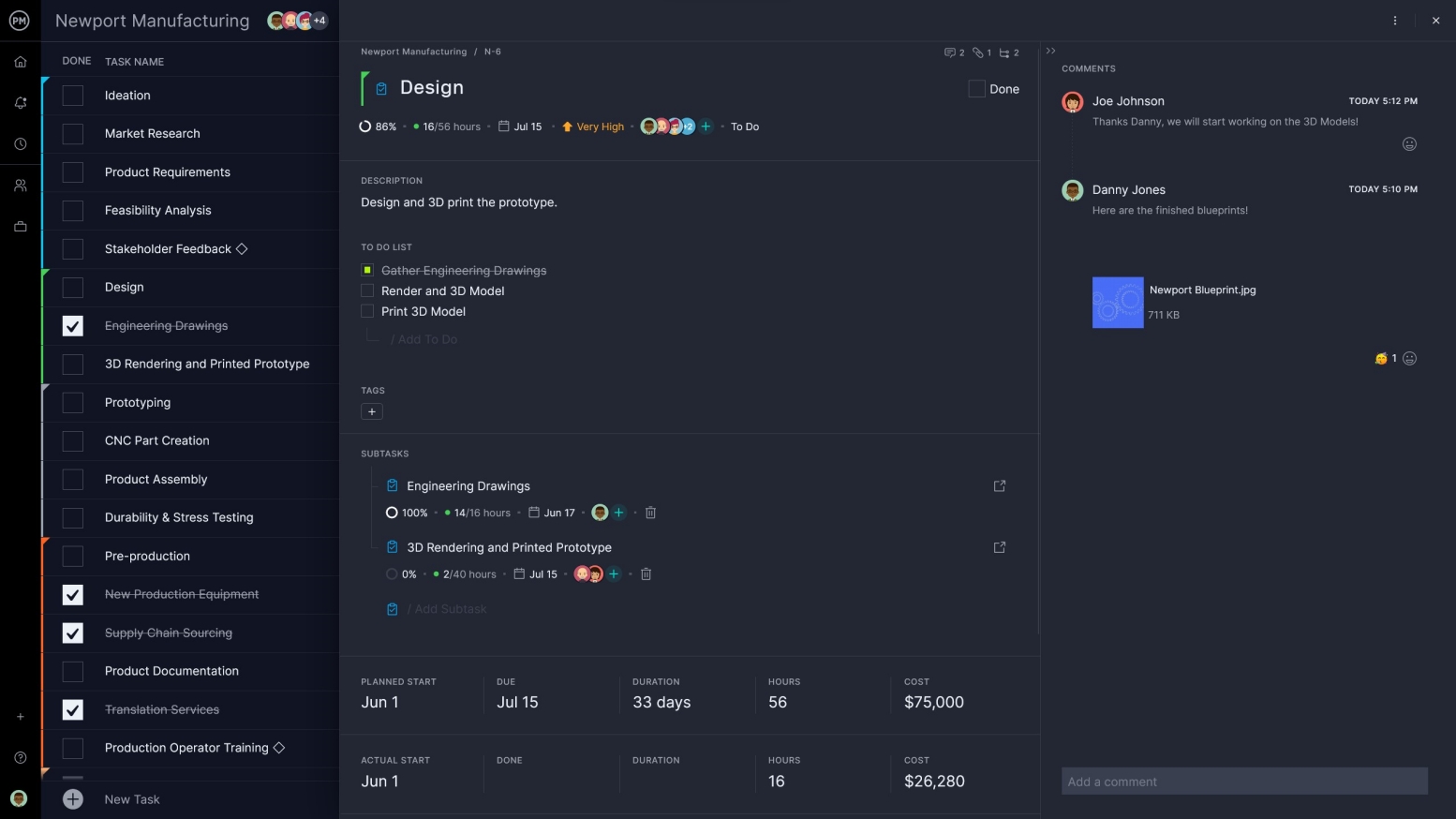
2. Add Your Resources to the Tool
Resources are your teams and the things they’ll need to execute their tasks. All of those resources must input into the software in order to manage and track their progress .
Onboard your team by inviting them to the project with the global add button in the top right corner. They will receive an email with a link. Once they follow that, they’re in and ready to start tracking their work.
3. Define Resource Costs
Calculating the cost of your resources is how you manage your budget. Keeping track of those costs is how you maintain your budget.
Add the labor rate for your resources, and set the cost by hours assigned. Our software automatically does the cost calculations for you as your team logs their hours and progresses through their tasks.
4. Schedule Resources on the Gantt
Resources (that aren’t people) need to be attached to tasks and added to your schedule to keep track of their costs throughout their life cycle in the project.
With ProjectManager’s Gantt chart you can create a resource calendar . Add your nonhuman resources the same way you onboarded your team. You can set their costs, then track them later in the project to keep on budget.

5. Track Time
Monitoring the hours logged by your resources is how you make sure they’re adhering to the project plan, schedule and budget.
Use timesheets to track the hours your team logs as they work. Their time updates are automatically reflected throughout the software.
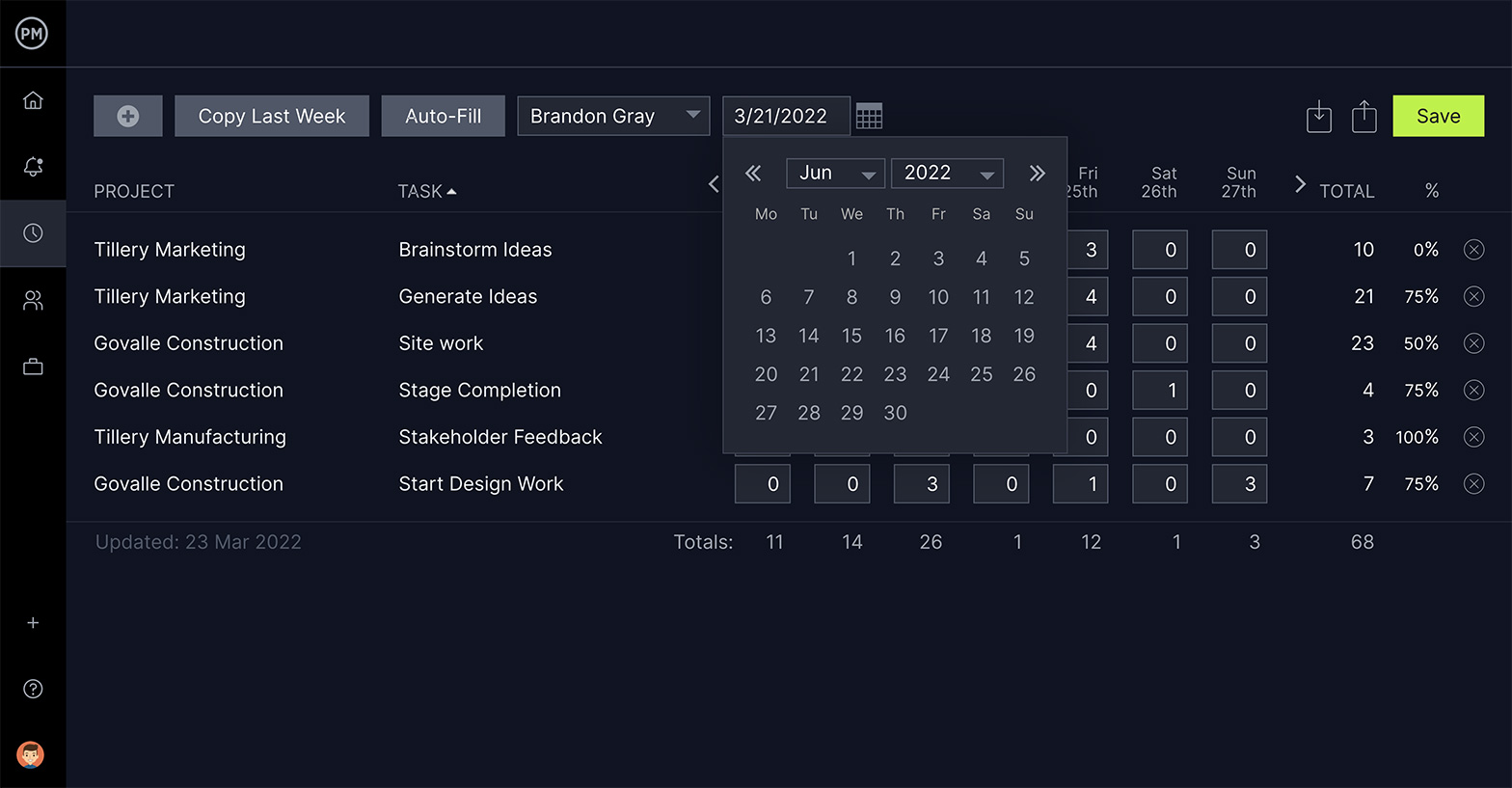
6. Balance Resources
Once the project is executed, it’s crucial to keep your resources matched with your production capacity , making sure you have just what you need, when you need it.
Keep your resources level by checking the workload page. Here, you’ll see a color-coded chart that shows if team members have too many or too few tasks. You can then reallocate their tasks from this page.
7. Report to Stakeholders
Stakeholders are the people who are invested in the project. They will want to stay up-to-date on progress and performance.
Generate reports on workload with a single click. Filter to show the data you want, then easily print or save as a PDF to share with your stakeholders.
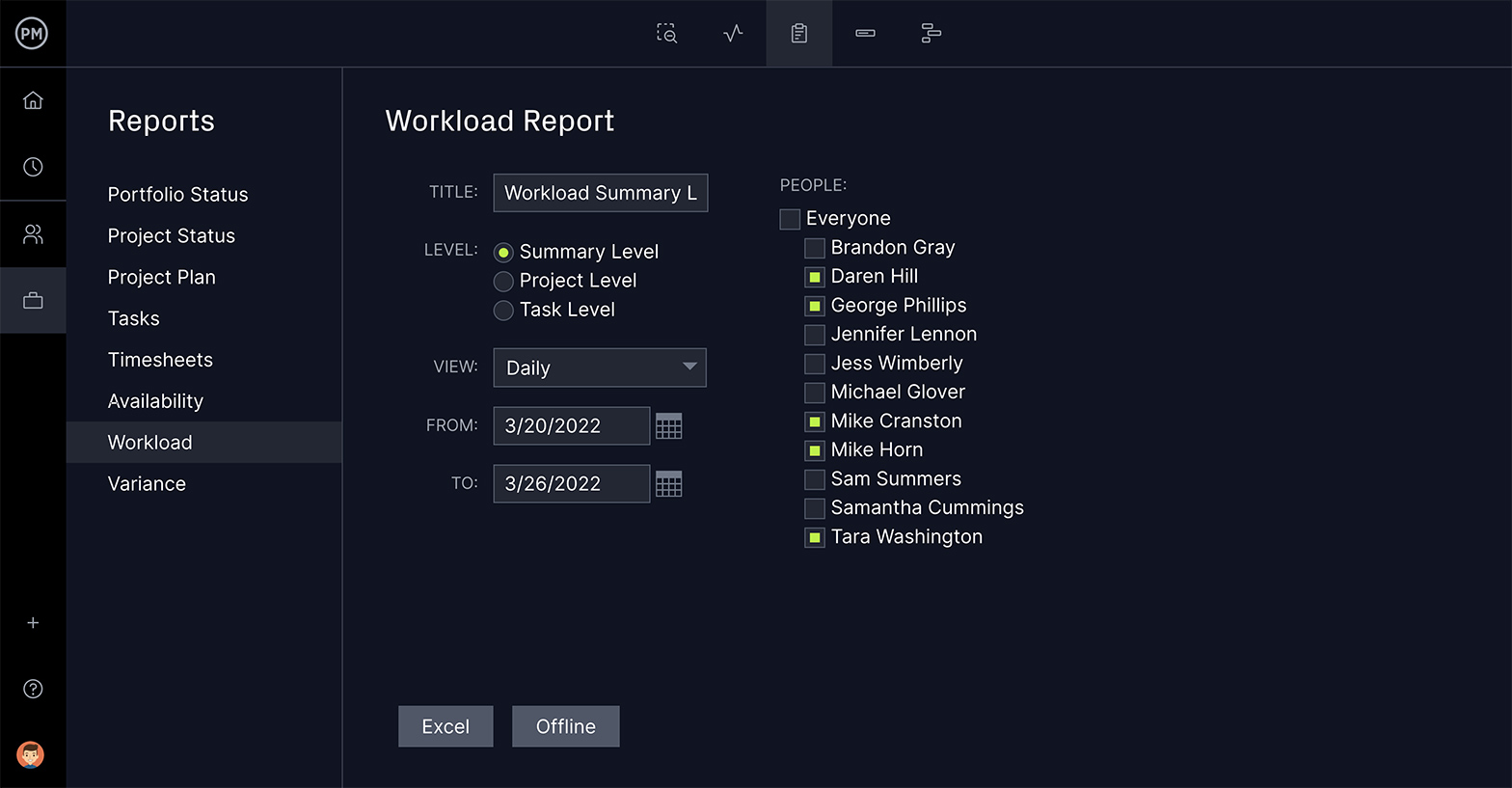
Ready to start managing your projects, tasks and resources in one tool? Take a free trial of ProjectManager.
Creating a Resource Management Plan: An In-Depth Look
So, those are the basic terms and processes. But how can you use them to create a process, schedule your resources throughout the project cycle , and monitor those resources within the boundaries of your budget, without overburdening them and risking team burnout? Lucky for you, we’ve covered the basics of resource planning before, and it can be distilled into a super basic three-step process.
First, note all your resources, including people, equipment and materials. Next, figure out how many of those resources are needed to get the project done. Finally, make a schedule for the resources. Drilling down, however, it’s important to make sure you have all the components of a good resource plan. It should include the following.
- All the Resources Necessary to Complete the Project: That’s everything from people to machines and even any office space you’ll need. Spend a good amount of time with this list, the more complete it is, the more accurate your schedule will be.
- Timeframes For the Planned Effort of Each Resource: By noting the duration of time needed for each resource, you have a clearer picture of how it will fit into your overall schedule.
- The Number of Each Resource You’ll Need Per Day/Week/Month: Again, you want to break your resource needs out on a daily, weekly and monthly rotation to better grasp what you’ll need and when.You can use a resource histogram to help you with this process.
- Quantity of Resource Hours Required Per Day/Week/Month: You’ve figured out what you need, but how many hours for each of those resources are you going to allocate over time?
- Assumptions and Constraints: An assumption is what you think might be true, while the constraints are the schedule, cost and scope of your project. So, you want to know what they are and how they’ll potentially impact your plan.
- Resource Constraints: In addition to the traditional project management constraints that affect how you manage resources, there are specific resource constraints that you’ll need to be aware of.
Think strategically. Are you assuming a team will be available in three months? Do you know for a fact they won’t get assigned by another group leader for a separate project? Have you taken into account holidays and scheduling shifts?
Identifying all your assumptions is a critical component of planning your resources wisely.
That’s the makings of a solid resource management plan. Now you need to know how to actively manage your resources as your project progresses.
You can do this when you have visibility into resource availability and workload. Because work shifts from person to person, as people collaborate back and forth, work can easily end up on the shoulders of only a few key team members. This can mean others are sitting idle waiting for them to reply or toss the work back. You need to be able to monitor those workflow trends and be able to quickly reallocate idle resources.
So how do you do this? There are four ways you can keep on top of the resources workload.
1. Manage Work Schedule Calendars Actively
You need to be able to track the hourly and daily availability of individual resources, as well as track their planned holidays and vacations. Be sure to take into account global or regional time differences, as well as different global holidays that might differ from your home office holiday calendar.
2. Monitor Progress on Gantt and Dashboard
You can also consult the planned versus actual progress of your overall project to get a head’s up if there’s a problem with resources. A Gantt progress bar should tell you how much progress is being made on a specific task according to the planned effort. You should also be able to see whether progress is made on individual tasks with shading on the larger task bars.

You should also be able to get a view of the whole project’s progress both by looking at a rolled-up view of the Gantt tasks or on a dashboard report. If you’re falling behind, usually moving around resources is a way to get back on track.
3. Review Workload Allocation
The team’s workload is another metric you’re going to need to keep close. If all the work is being laid on the shoulders of only a few team members, while the others are idle, then you’re going to need to reallocate your resources.
Another way of looking at this is leveling your resources by ensuring that they are equally distributed across your team. Checking on workload is a daily part of keeping your resources well-allocated.
4. Get Resource Reports to Monitor Productivity
When you’re watching your resources in real-time, and the project’s success is on the line, then you’re going to need to make decisions swiftly. Use the reporting feature of your project management tool to produce reports on resource allocation, as well as task progress by an individual. It’s important to monitor resources regularly with deep dives into data to measure productivity KPIs like output and actual effort.
Remember, resource management is heavily linked to your scheduling and management of your project management schedule . These are different but complementary disciplines, and the more holistically you approach managing your resources, the more you’ll be able to act in a timely manner to keep your project moving towards success, on time and within budget.
Therefore, you want to have the right resource management tools to keep you informed of your resources while the project is in progress, whether that’s collecting data in an Excel spreadsheet or a more robust online PM tool. Using an online Gantt chart gives you a visual view of the project’s tasks, their durations, and whatever dependencies are linking one task to another, so you’re able to note bottlenecks and easily reallocated resources to get the project back on track. Try ProjectManager today to take advantage of the best resource management tools on the market.
Start My Free Trial
Resource Plan Resources
- Resource Management Software
- Best Resource Management Software Rankings
- Scheduling Software
- Gantt Chart Software
- Timesheet Software
- Resource Plan Template
- Gantt Chart Template
- Capacity Planning Template
- Project Management Dashboard Template
- Project Budget Template
- Timesheet/Time Tracking Template
- How to Make a Resource Breakdown Structure (RBS)
- 12 Resource Allocation Tips for Managers
- How to Calculate Resource Utilization for a Project
- What Is Resource Loading and Why Does It Matter in Project Management?
- 5 Tips for Better Resource Scheduling
- Resource Leveling 101: Master this PM Technique
- Organizational Resources Basics: Managing Company Resources
- Resource Smoothing Steps, Templates and Tools
Start your free 30-day trial
Deliver faster, collaborate better, innovate more effectively — without the high prices and months-long implementation and extensive training required by other products.

How it works
For Business
Join Mind Tools
Article • 6 min read
The Responsibility Assignment Matrix (RAM)
Knowing where the buck ultimately stops.
By the Mind Tools Content Team

It takes a lot of effort to keep a large project running smoothly. With a large number of variables, people, and deliverables, it’s hard to keep on top of everything that’s happening. Consider the following scenario:
Hal (the distressed project manager): "What do you mean, we don’t have the test results yet?! What has Katy been doing? Get Katy!"
Katy: "No, Hal, I wasn’t responsible for getting that done. Joan has more expertise in that area, remember? I’ll ask Joan what happened."
Joan: "Gee, Katy, I know I have more experience with these reports, but I was waiting for you to contact me so we could review them together."
Do you recognize anyone you know? This type of situation is repeated daily in organizations across the globe. And most of the time, there’s no incompetence or bad intentions involved. More often, problems like this are the result of inadequate planning and poor communication.
Successful projects have a clear breakdown of who is ultimately responsible for each aspect of the project. Without clear, written, and agreed-upon accountability, it’s far too easy to for communication to fail and for responsibilities to be muddled.
So how do you avoid this?
Developing a Responsibility Assignment Matrix
One tool that project managers use to keep these assignments clear is the Responsibility Assignment Matrix (also called the RAM, or the Responsibility Matrix). This matches deliverables with the people who are responsible for them. For every piece of the project, the matrix shows who needs to contribute what for the project to be completed.
For example, let’s say that you’re upgrading your customer service delivery system, and you need to train your staff to use new procedures and tools.
Step One: Define Your Deliverables
Using a Work Breakdown Structure , you define three key deliverables for this training project, with a few subcategories for each:
- Survey current practice.
- Define new practice.
- Locate resources.
- Prepare training schedule.
- Manage training.
- Re-survey practices after implementation.
- Analyze results.
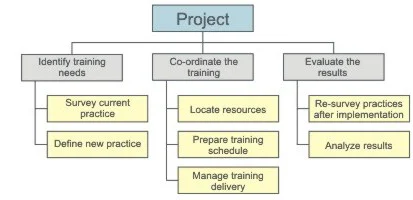
A Work Breakdown Structure (WBS) is a project planning tool used to break a project down into smaller, more manageable pieces of work (deliverables). It's not a list of every task: rather, it's a "tree" structure showing the meaningful groups of activities that make up the main segments of the project.
Step Two: Identify the People Involved
Map out who is on your project team. By creating a chart of individuals who are available, you can then delegate work assignments based on expertise, and you can recruit talent that you’re missing. This step is often called an “Organization Breakdown Structure” because it creates an organizational chart for your team.
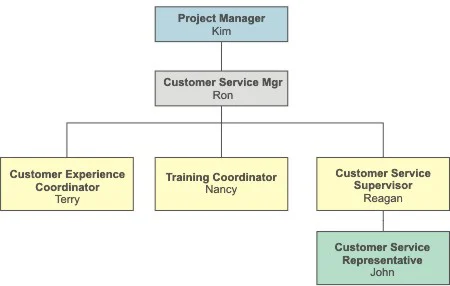
Step Three: Create Your Responsibility Matrix
Draw a matrix. The deliverables are the column headings, and the people are the row titles.
With your team, determine accountabilities as well as other levels of involvement for each item in your Work Breakdown Structure.
A useful framework to determine role assignments is RACI . This defines four levels of involvement:
R = Responsible (People who do the work). A = Accountable (People who make sure the work gets done). C = Consulted (People who provide input before and during the work). I = Informed (People who are kept informed of progress).
Project Management Institute, "A Guide to the Project Management Body of Knowledge (PMBOK Guide)" – Fifth Edition, (2013). Copyright and all rights reserved. Material from this publication has been reproduced with the permission of PMI.
Other levels of involvement may include “assist”, “coordinate”, “sign off”, and “review”. You can decide how to assign responsibility for your project and your team. But you must be sure that ultimate accountability and responsibility for performing the work are agreed upon and communicated.
Step Four: Communicate
When your Responsibility Assignment Matrix is complete, communicate it to all stakeholders. It’s a good idea to post it in an area where people will see it. Used effectively, the RAM helps people understand what they should be doing at all stages of the project.
Project teams can easily lose focus on what needs to be done and who needs to do it. People may assume that somebody else is doing something – and before long, key pieces of work fall behind schedule.
To avoid this common problem, consider developing a Responsibility Assignment Matrix for your team. This matrix clearly identifies which role each team member has agreed to take on for each of the project’s main deliverables.
With these assignments, you can eliminate miscommunication about who’s doing what – and you can help to ensure that your project is successful.
You've accessed 1 of your 2 free resources.
Get unlimited access
Discover more content
Expert Interviews
Personal Branding
The apple experience.
Carmine Gallo
Add comment
Comments (0)
Be the first to comment!

Team Management
Learn the key aspects of managing a team, from building and developing your team, to working with different types of teams, and troubleshooting common problems.
Sign-up to our newsletter
Subscribing to the Mind Tools newsletter will keep you up-to-date with our latest updates and newest resources.
Subscribe now
Business Skills
Personal Development
Leadership and Management
Member Extras
Most Popular
Newest Releases

Team Briefings

Onboarding With STEPS
Mind Tools Store
About Mind Tools Content
Discover something new today
New pain points podcast - perfectionism.
Why Am I Such a Perfectionist?
Pain Points Podcast - Building Trust
Developing and Strengthening Trust at Work
How Emotionally Intelligent Are You?
Boosting Your People Skills
Self-Assessment
What's Your Leadership Style?
Learn About the Strengths and Weaknesses of the Way You Like to Lead
Recommended for you
How to take care of your "social battery".
Preventing Social Burnout
Business Operations and Process Management
Strategy Tools
Customer Service
Business Ethics and Values
Handling Information and Data
Project Management
Knowledge Management
Self-Development and Goal Setting
Time Management
Presentation Skills
Learning Skills
Career Skills
Communication Skills
Negotiation, Persuasion and Influence
Working With Others
Difficult Conversations
Creativity Tools
Self-Management
Work-Life Balance
Stress Management and Wellbeing
Coaching and Mentoring
Change Management
Managing Conflict
Delegation and Empowerment
Performance Management
Leadership Skills
Developing Your Team
Talent Management
Problem Solving
Decision Making
Member Podcast

Creating a Resource Matrix in Project Management

Efficient resource allocation is a critical aspect of successful project management. Without a clear understanding of available resources and how they align with project tasks, organizations can face challenges such as missed deadlines, budget overruns, and compromised project quality. To overcome these hurdles, project managers rely on a powerful tool known as the resource matrix. Here we will explore what a resource matrix is, its benefits, and how to create one to optimize resource allocation in project management.
Project Resource Planning: Understanding Different Approaches
For each project manager, there’s their own favorite way to create the project management schedule. There are the ones that still prefer to plan on a whiteboard . Ones that have found a spreadsheet-based resource planning template that works for them.
There are the ones that plan create a work breakdown structure and then schedule the tasks using it. While, some project managers like to assign the resources right away and those that prefer to schedule the tasks first.
Here’s a breakdown of some of these approaches and the different tools used to reach the goals set.
Project Resource Management Techniques
- Project-based resource planning That’s where projects are at the top of the project management food chain and resources are just means to an end. Project resource planning is often more about planning, rather than optimization. It’s allocating resources to tasks, not the other way around. Here it’s all about staffing projects and ensuring capacity for project tasks. With little to no emphasis on optimizing resource utilization.
- Resource-based project planning In resource-based project planning, the approach is reversed compared to project-based planning. The main goal here is to keep resource utilization at an optimal level . Tasks are allocated to available resources, and project planning takes a backseat. The emphasis is on efficiently utilizing resources while project considerations are secondary.
- Matrix planning Matrix planning combines the best aspects of both project-based and resource-based approaches. It focuses on task allocation while considering both resource capacity and project capacity. The goal is to maximize project efficiency by ensuring resources are allocated optimally. This approach involves planning for individual projects and pivoting the resource plan to assess how it aligns with overall resource utilization. Matrix planning strikes a balance between project requirements and resource optimization.
Basically though, if you’re a manager who plans resources and projects. Seeing how both fit together is optimal. That way you always know if the project you have scheduled will have the right capacity to get it done. Without worrying if you’re overburdening anyone in the process. That’s where a resource matrix comes into play.
Understanding the Resource Matrix
A resource matrix, also known as a staffing matrix or resource allocation chart, is a visual representation that maps project tasks or activities against the resources required to complete them. It provides an overview of the project’s resource needs and helps in identifying potential bottlenecks or imbalances in resource allocation. The matrix typically includes information such as the names or roles of team members, their availability, skills, and the tasks they are responsible for.
In general, matrix planning is a resource management technique where you lay out your projects and resources as a visual plan. This allows you to see the connected resources to projects and vice versa. This management technique puts equal emphasis on projects and resources, and the way to achieve this means seeing the project and resource schedules from all possible angles.
The reason why managers love it so much is that it gives the best possible overview of how everything comes together. It’s the big picture and the small details all in one.
Benefits of a Resource Matrix
Matrix planning takes the best of both worlds of project and resource planning. With it you can ensure that resources are allocated to maximize project efficiency. While also taking into account utilization. It’s planning for one project and pivoting the resource plan to see how it all comes together. This in turn creates some big benefits for your organization and staff. Including:
- Efficient Resource Allocation – By creating a resource matrix, project managers gain a clear understanding of the availability and skills of team members, enabling them to allocate resources optimally. This prevents overloading certain individuals or departments while ensuring all project tasks are adequately staffed.
- Improved Planning and Scheduling – A resource matrix helps in aligning project timelines with resource availability. It allows project managers to identify potential resource constraints and make informed decisions regarding task sequencing and scheduling.
- Risk Identification and Mitigation – With a resource matrix, project managers can proactively identify potential resource gaps or bottlenecks that may impact project delivery . By identifying risks early on, they can take appropriate measures to mitigate them, such as hiring additional resources or redistributing tasks.
- Enhanced Collaboration and Communication – A resource matrix facilitates transparent communication among team members and stakeholders. It helps everyone involved understand the resource requirements and availability, fostering collaboration and enabling effective decision-making.
Creating a Resource Matrix
When you’re ready to begin giving matrix planning a shot, here’s the steps to take in creating one.
- Identify Project Tasks Begin by listing all the tasks or activities required to complete the project. Break them down into smaller, manageable components to ensure comprehensive coverage. This is your classic work breakdown structure (WBS), that usually comes at the beginning of project scheduling.
- Determine Resource Requirements Now add to your resourcing demands. Achieve this by assessing the skills and expertise needed for each task. Then you can begin to identify the resources (team members, departments, or external contractors) that possess those skills. Consider factors such as availability, workload, and any constraints or dependencies.
- Design the Matrix Create a grid or table where each row represents a resource, and each column represents a project task. Fill in the matrix with the names or roles of resources against the tasks they are responsible for. While a simple table in Excel works, a resource-based Gantt chart can be even better for this step!
- Add Resource Details Include relevant information about each resource, such as availability (e.g., hours per week), skill sets, and any specific constraints or dependencies. This data will assist in making informed decisions once you begin executing your projects. Tip! In resource planning software, use custom resource data fields to fill out this info.
- Review and Adjust Regularly review and update the resource matrix as the project progresses. This ensures that changes in resource availability, project priorities, or task dependencies are reflected accurately, allowing for agile resource allocation.
Matrix Planning in Ganttic
A resource matrix is the first step to better project management. And a simple one can be created in any kind of Gantt chart software or even with a template in Excel. As long as you get the visual overview of your resource pool and task list, that’s what counts.
But to ensure your projects are aligned with resource capacity, you’ll need to switch up how you see the matrix.
In Ganttic’s Single Project View , you can switch between Resource and Task modes. This allows you to schedule unassigned tasks which can later be assigned to the right resource once you’re ready. From there it’s simple to flip back and forth from a Project View and a Resource View. Giving you a complete overview from different angles.
Here we’ll get you how to set yourself up to do your own project resource matrix planning.
1. Add a new Project to Ganttic
The first thing you’ll need to do is add a new project to your planner. Customize this and add in details by filling out the custom data fields . These include signifiers like the project reference number, project manager, the status of the project, or the different milestones and phases of the project.
2. Open a Single Project View
Next, you open the project in a Single Project View . From there it’s simple to start scheduling tasks for the project without worrying about the resources. Some like to define the tasks beforehand, others do it on the go.
If you need some tips on how to estimate task duration, read our blog post here .
3. Add Tasks
Begin creating your WBS by adding tasks to the project. All tasks added in a Single Project View will automatically be connected to the larger project. There’s 2 kinds of tasks that can be added, those with resources (assigned tasks) and those without (unassigned tasks). Proceed as you see fits.
Adding assigned tasks:
Choose the All Resources mode and simply drag and drop the tasks to a resource. All tasks created this way will automatically have a resource attached. Once it’s scheduled, the Task Edit Dialog will appear. That’s for you to add any additional details if needed.
In this mode, you’ll see the placeholders for any other work assigned to your resources. This ensures that no one is overbooked in the process. You can also turn on availability settings, so you track the available time each resource has, even if it’s work on other projects.
Task placeholders and Resource availability can be hidden or adjusted in the Visibility Settings.
Check in on any of the assigned tasks in the Project Resources mode . This will only display the ongoing work and timeline for this one project. As well as only that project’s resources.
Adding unassigned tasks:
If you don’t know what resource is the best fit yet, then choose the Task mode . These tasks can be as detailed as you like. You don’t even have to add a title if you’re not sure yet!
Now, you’ll have a bunch of unassigned tasks. However, these tasks will be automatically connected to the project so you can easily differentiate them in the general resource plan using project colors .
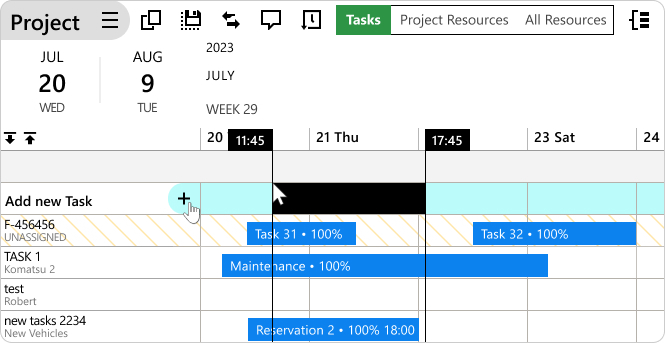
4. Allocate Resources
If you use unassigned tasks, you will now need to begin assigning the right resources for the jobs. Again, there are many roads to take.
For those of you that are here just for the high-level resource planning, switch to the All Resources mode . This will display the entire resource pool. From here you can simply drag the tasks to the resource you’d like to take on the work.
If you want to assign the task to multiple resources (for example to different team members plus a piece of equipment), you can do it using the + that appears next to resource title once you open the Task Edit Dialog.
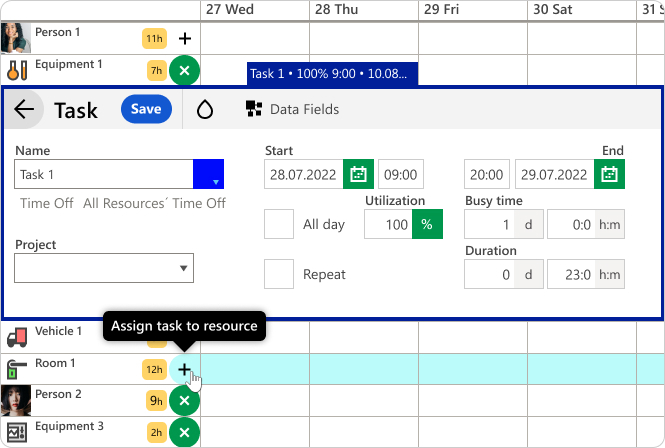
If you are for a more organic approach to project management scheduling, you can also do things a bit differently. Since research has shown that the best and most efficient approach to resource management is the kind that involves the resources, we recommend you to take that road. See which resources are available and hold a meeting . Maybe have a framework in mind and discuss the tasks. From there, let the top performers choose the tasks that they want to take on. If you have your planner open, you can even add the tasks as you go. Now that’s transparent, effective scheduling!
Narrow down the resource pool by adding filters (based on skills sets, certifications, location, and other criteria you’ve outlined with custom data fields) and availability settings (such as available time, or utilization rate).
5. Monitor the Resource and Project Matrices
For a full matrix planning experience, change between these modes and even different Views. While the Single Project View offers a detailed plan of one project, it’s also good to take on the big picture. So designing and utilizing an All Projects View will give you a complete overview of the entire portfolio.
No matter your preferential way of planning Ganttic has you covered. Hop on over to our Help Desk for more tips on planning. Or book a free demo at anytime.
Choose Your Planning Style with Ganttic
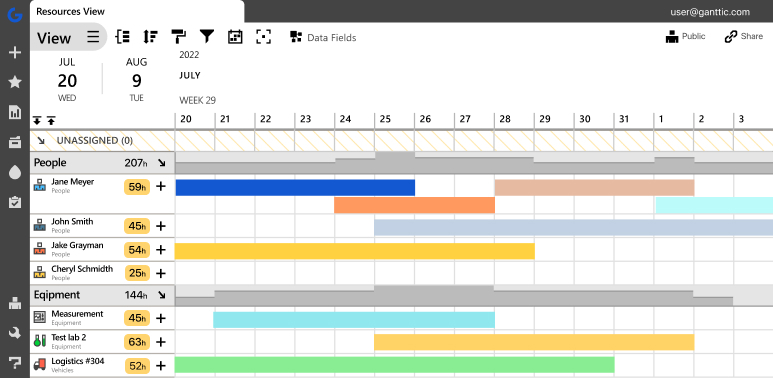
Efficient resource allocation is crucial for project success, and a resource matrix serves as a valuable tool in achieving this goal. Begin today by incorporating this powerful technique into your project management arsenal to optimize resource allocation and drive successful project outcomes.
When it comes to project management, having a clear vision and knowing what you want is half the battle. With Ganttic, you have the power to build your ideal workflow from start to finish. Whether you’re initiating a project, planning tasks, allocating resources, or visualizing your project timeline. Ganttic’s matrix planning approach to project resource management provides the flexibility and control you need to bring your vision to life. With Ganttic, you have the perfect companion to transform your ideas into successful projects, making your journey as a project manager smoother and more efficient.
Make your vision a reality.
Link copied!

Liven Up Project Management with Color
Colors have special powers. Without words or context, a new shade can give objects a different meaning or highlight severity. For example, red often denotes danger and urgency. While green…

Scheduling Techniques in Project Management
A project schedule is the key to delivering on your work promises and goals. It’s an outline of not only what you hope to achieve, but the path and resources…

Multi-Resource Task Scheduling: Planning The Easy Way
We added Multi Resource Task list to Ganttic Task Dialog window to make multi-resource scheduling more convenient. Check out the newest update!

Creating an Employee Skills & Staff Matrix
A skills matrix is used to identify the skills and competencies of your team members. With it managers can assign tasks more effectively, give your team the knowledge to grow,…
Deliver an accurate picture of your plans. Start now for free.
14-day free trial. No credit card required.
- Get started Get started for free
Figma design
Design and prototype in one place

Collaborate with a digital whiteboard

Translate designs into code

Get the desktop, mobile, and font installer apps
See the latest features and releases
- Prototyping
- Design systems
- Wireframing
- Online whiteboard
- Team meetings
- Strategic planning
- Brainstorming
- Diagramming
- Product development
- Web development
- Design handoff
- Product managers
Organizations
Config 2024
Register to attend in person or online — June 26–27

Creator fund
Build and sell what you love
User groups
Join a local Friends of Figma group
Learn best practices at virtual events
Customer stories
Read about leading product teams
Stories about bringing new ideas to life

Get started
- Developer docs
- Best practices
- Reports & insights
- Resource library
- Help center
What is a RACI matrix? (with examples)
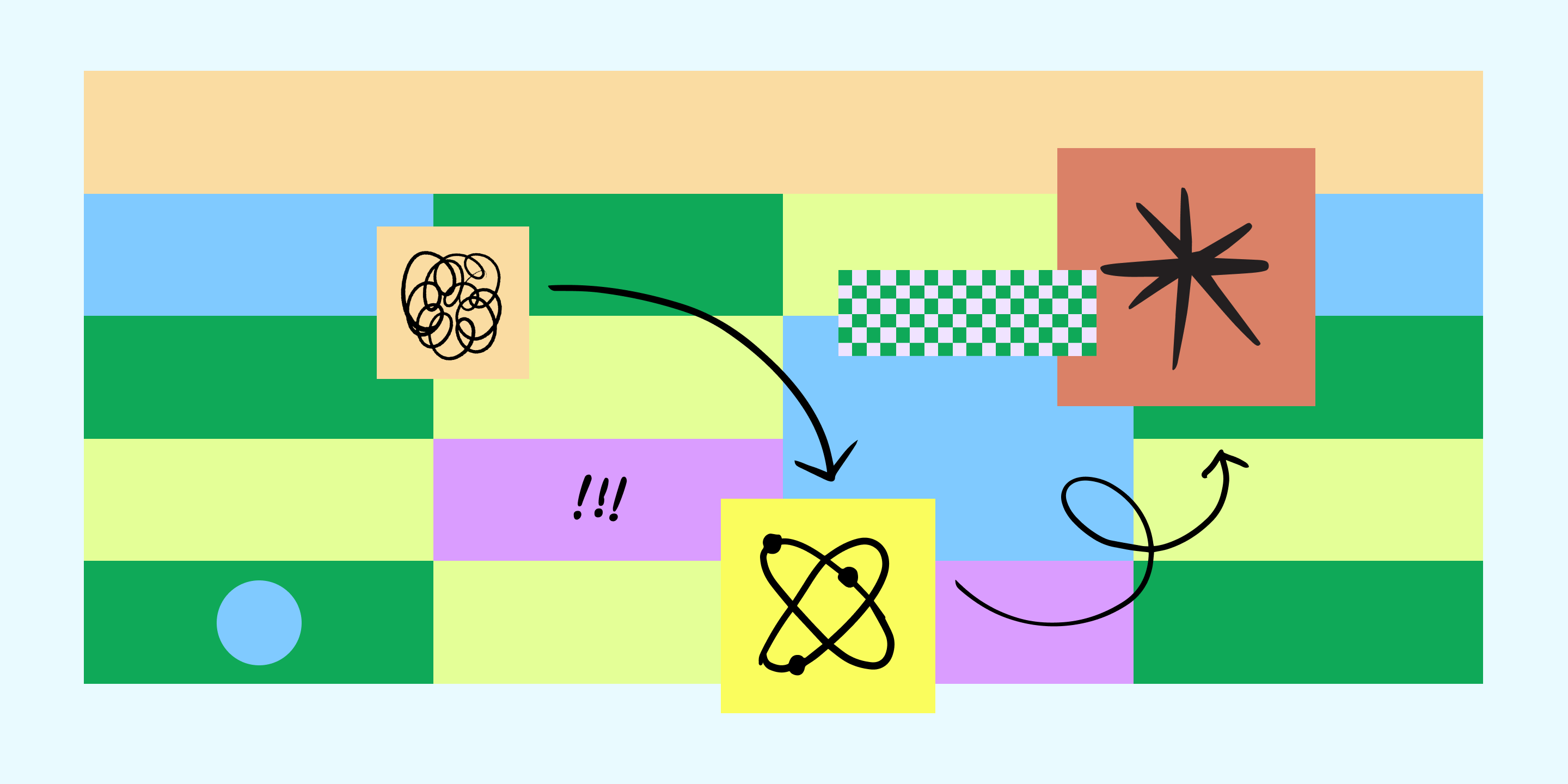
Say your team is asked to design a new product feature. Exciting news—but you'll need more information before you get cracking. Who's approving the project, building it, and managing the timeline? The quickest way to collect and communicate that information is a RACI matrix, a diagram that shows who's doing what on your project.
With this guide, you'll discover:
- What a RACI matrix is, and how it assists with project management
- How to improve your project plan with a responsibility matrix
- How to build your own RACI diagram with FigJam's RACI chart template
What is a RACI matrix?
A RACI matrix—often called a RACI chart or responsibility assignment matrix (RAM)—is a project management tool that captures the roles and responsibilities of project stakeholders. Team members can see who does what at a glance, clarifying different roles across complex projects. The acronym RACI stands for:
- Responsible refers to the individual or group performing a particular task. For example, the UX team might be tapped as the responsible party for mapping out specific product design features. Make sure each task has at least one responsible person.
- Accountable refers to the person who ensures a task is completed successfully. To avoid confusion, make sure teach task has only one accountable role. This is usually filled by a manager or a high-level team member with the authority to delegate project tasks.
- Consulted describes individuals whose feedback factors into project workflows, but aren't involved in day-to-day tasks. This includes subject matter experts or decision makers who are consulted for input or sign-off on project milestones. For example, a business analyst may be consulted about competitive research to inform design decisions.
- Informed describes anyone who needs updates on task progress across project phases, but isn't necessarily involved in task execution. For example, developers building design features may need real-time updates on design task completion or setbacks to plan their work.
In this matrix example , the UI designer is responsible for creating the design and the product owner is accountable for making sure that design gets done. The content writer may be consulted, and the CEO is informed about project milestones.
4 key benefits of a RACI matrix
The RACI matrix is commonly used in agile and scrum methodologies because it helps keep complex projects moving toward successful completion in four key ways:
1. Role clarity
By clearly defining Responsible, Accountable, Consulted, and Informed roles, a RACI matrix minimizes confusion, ambiguity, and overlap. This ensures that everyone involved in the project is on the same page and understands what is expected of them.
2. Communication
A RACI matrix outlines who should be consulted and informed at every stage of the project. This invites open and consistent communication—the lifeblood of any team project.
3. Efficiency
Outlining distinct roles and responsibilities with a RACI chart helps streamline team efforts and clarify project tasks, helping your project run smoother and faster.
4. Accountability
When you put your RACI matrix on your project dashboard, everyone can see who's responsible for which tasks and project deliverables. This establishes shared accountability, fostering teamwork and ownership among team members.
How to build a RACI matrix in 5 steps
You can create a RACI matrix for effective project management in five steps using this RACI matrix template in FIgJam.
- Outline all tasks. Start by listing all the tasks or deliverables for the project. In the first column of your table, prioritize and arrange tasks in the order they must be accomplished.
- Identify project team members. Name all team members or stakeholders involved in the project. List them across the top row.
- Assign project roles. For each specific task, assign RACI roles (Responsible, Accountable, Consulted, and Informed) to the appropriate team member. Make sure to assign one accountable person per task, to keep project progress on track.
- Review and revise. Double check that each project task is identified and every team member's role is represented. Leaving out tasks or roles can create confusion and leave project gaps. Plan regular reviews to update the matrix with ongoing changes, like completed tasks, role shifts, or new tasks.
- Communicate and implement. Whenever possible, involve the whole team in the creation of the RACI matrix. To build buy-in and understanding. Once project team members and stakeholders sign off on the matrix, incorporate the tasks into your project management process.
3 alternative approaches to RACI charts
While the RACI model is widely used, this exhaustive list provides alternatives. These three may be more suitable depending on a project's or organization's needs:
- RAPID : This methodology created by Bain & Company coordinates decision-making in five steps: Recommend, Agree, Perform, Input, Decide.
- DACI : This framework aids group decision-making by assigning specific roles: Driver, Approver, Contributor and Informed.
- RASCI : This variation of the RACI model acronym includes an additional "S" for Supportive team members.
Jumpstart your RACI matrix with FigJam
To make your own RACI matrix, try the free FigJam RACI matrix template . Then finesse your matrix with these pro tips:
- To get your team involved with your RACI, use FigJam's collaborative features like stamps, stickers, emotes, and high-fives .
- Transform tasks and deliverables into actionable to-dos with FigJam's task management widgets, project management integrations, and Gantt chart maker .
- Customize your matrix with brand elements from your company's Figma brand library.
- For more inspiration, browse the library of RACI matrix templates shared by the Figma design community.
Ready to assign project roles and responsibilities?
Keep reading
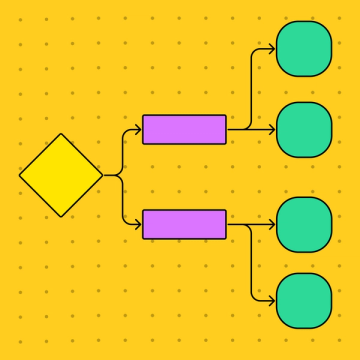
How to create a flow chart
Having a flow chart can help visually represent actions or people in a complex situation.
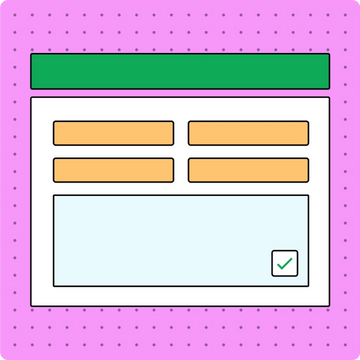
How to create a project status report
Whether you’re developing a new product or launching a marketing campaign, your company’s success hinges on keeping your project on track

How to run great daily standups
How do you make sure everyone's on board, on task, and on track for a productive day ahead?

- Onsite training
3,000,000+ delegates
15,000+ clients
1,000+ locations
- KnowledgePass
- Log a ticket
01344203999 Available 24/7
Responsibility Assignment Matrix: A Complete Overview
Dive into the world of Responsibility Assignment Matrix (RAMs), which helps assign roles and responsibilities and how they streamline Project Management. This comprehensive blog explains their purpose, benefits, and practical use, enabling effective role definition and accountability in project teams. Continue reading!

Exclusive 40% OFF
Training Outcomes Within Your Budget!
We ensure quality, budget-alignment, and timely delivery by our expert instructors.
Share this Resource
- Project and Infrastructure Financing Training
- Waterfall Project Management Certification Course
- Jira Training
- CGPM (Certified Global Project Manager) Course
- Project Management Office Fundamentals Certification Course

This comprehensive blog aims to provide you with a complete overview of the Responsibility Assignment Matrix and its pivotal role in Project Management and organisational structure.
Table of Content
1) What is a Responsibility Assignment Matrix in Project Management?
2) Responsibility Assignment Matrix (RAM) goal in Project Management
3) How to create a Responsibility Assignment Matrix?
4) Benefits of Responsibility Assignment Matrix
5) Developing Responsibility Assignment Matrix (RAM) best practices
6) Conclusion
What is a Responsibility Assignment Matrix in Project Management?
A Responsibility Assignment Matrix (RAM) in project management is a tool that outlines and defines the roles and responsibilities of individuals or groups involved in a project. Its purpose is to ensure that everyone understands their specific duties and tasks. The primary purpose of a RAM is to bring clarity to the project structure, helping to prevent confusion, overlap, and accountability issues throughout the project lifecycle.
RAM in Project Management is also known as Responsible, Accountable, Consulted and Informed (RACI). RACI represents different levels of roles and responsibilities for individuals or teams:
a) Responsible: The individual or group in responsible for finishing a certain job or project. They are the ones who perform the work.
b) Accountable: The individuals who have complete responsibility and decision-making authority over the job or result. They ensure that the task is completed and of satisfactory quality.
c) Consulted: Individuals or stakeholders are consulted for their views or skills before to making a decision or taking actions. They contribute essential insights but may not be directly responsible for the task.
d) Informed: Individuals or stakeholders who need regular updates on the task’s progress or result. They are not actively involved in its conclusion, but they must be notified of any advancements.

Responsibility Assignment Matrix goal in Project Management
The primary goal of a Responsibility Assignment Matrix in Project Management is to clearly define and communicate the roles and responsibilities of individuals or teams involved in a project. Here are the key goals of using a RAM in Project Management:
a) Clear roles and responsibilities: The RAM establishes clear roles and responsibilities for each team member, minimising confusion and conflicts.
b) Enhanced communication: Documenting roles and responsibilities concisely in the RAM facilitates effective communication within the project team. Also, enabling quick identification of contacts for specific issues or inquires.
c) Conflict resolution: BY operating a reference point, the RAM helps to resolve conflicts or misunderstandings about responsibilities, providing a foundation for conversation and conflict resolution.
d) Improved project control: With the RAM in place, Project Managers and stakeholders can more easily monitor project progress, identifying task accountability and monitoring work package status.
e) Efficiency and accountability: By allocating responsibility to each project aspect, the RAM promotes accountability among team members, resulting in increased efficiency as everyone understands their duties and expectations.
f) Risk Management: The clear roles of RAM help detect potential hazards associated with functional gaps or overlaps, enabling proactive risk mitigation strategies.
g) Optimal Resource Allocation: Project managers can optimise resource allocation by understanding task ownership and workload distribution as described in the RAM.
Ready to lead digital service projects to success? Register for our Certified Digital Services Project Manager (CDSPM) Course today!
How to create a Responsibility Assignment Matrix?
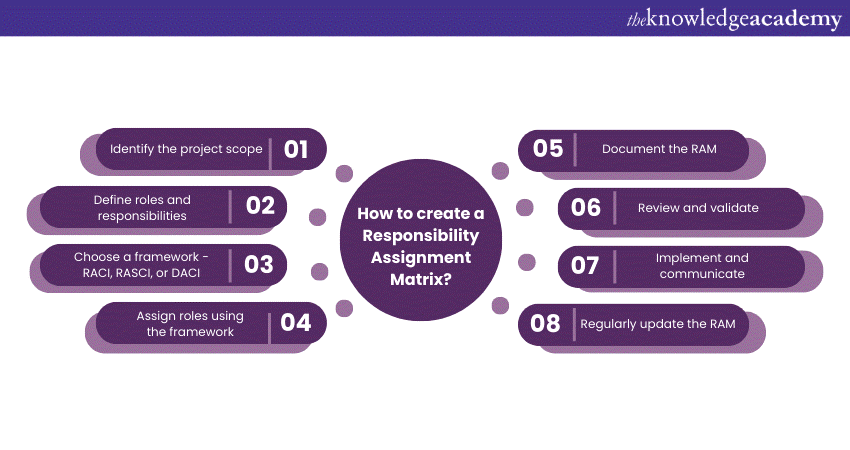
Identify the project scope
Start by recognising the project's scope or the exact purpose for which you are building RAM. This includes establishing project objectives, outcomes, and critical milestones.
Define roles and responsibilities
a) Identify the key roles involved in the project. Common roles may include Project Manager, Team Leader, Team Member, Stakeholders, and other relevant positions.
b) Clearly define the responsibilities associated with each role. These responsibilities should be specific and measurable so there is no ambiguity.
Choose a framework - RACI, RASCI, or DACI
a) Select a framework for your RAM. The most commonly used frameworks are RACI, RASCI, and DACI:
b) RACI: RACI Stands for Responsible, Accountable, Consulted, and Informed. It defines who is responsible for a task, who is accountable for its completion, who needs to be consulted, and who needs to be informed.
c) RASCI: RASCI Similar to RACI, but with an additional role, the "S" for Support. This framework further clarifies who provides support for a task.
d) DACI: This framework is similar to RASCI but adds the role of Driver. The Driver is responsible for ensuring that a task is completed.
Assign roles using the framework
a) For each task or work package within the project, assign the relevant roles using the chosen framework. Each task should have a Responsible person, an Accountable person, and, if necessary, people who need to be Consulted, Informed, or Supported.
b) Be specific and ensure that there is only one person designated as "Accountable" for each task to avoid confusion.
Document the RAM
a) Create a table or chart that lists all the tasks or work packages on one axis and the identified roles on the other.
b) Fill in the matrix with the appropriate role designations (R, A, C, I, S, D) for each task and role.
Review and validate
Share the RAM with the project team and stakeholders for evaluation and approval. Confirm that everyone agrees on the roles and responsibilities.
Implement and communicate
Once the RAM has been completed and approved, communicate it to the project team and other stakeholders. Ensure that everyone understands their jobs and responsibilities.
Regularly update the RAM
As the project evolves, it is critical to improve the RAM as necessary. Roles and duties might shift, and new tasks may develop. Keep the RAM current to reflect the project's evolving needs.
Unlock your potential as a Program Manager with our Programme Management (PgM) Fundamentals Course !
Benefits of Responsibility Assignment Matrix
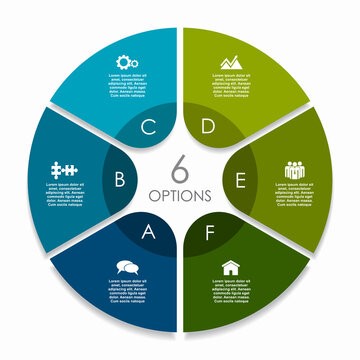
a) Clarify roles and responsibilities: A RAM clearly defines who is responsible for each task, which helps prevent confusion and ensures that team members understand their roles.
b) Improved communication: The RAM serves as a central reference point for roles and responsibilities, promoting effective communication within the project team. Team members can quickly identify who to contact for specific issues or questions.
c) Conflict resolution: When there is a dispute or ambiguity regarding responsibilities, the RAM provides a basis for discussion and conflict resolution. It helps identify where accountability lies and facilitates problem-solving.
d) Enhanced project control: The RAM allows Project Managers and stakeholders to monitor and manage the project's development. It helps you to track the status of assignments and ensure that tasks are getting done as planned.
e) Efficiency and accountability: Clearly defined roles and responsibilities create a sense of responsibility among team members, maybe resulting in improved productivity. When people understand what is required of them, and they are more likely to fulfil it.
f) Resource allocation: The RAM helps Project Managers optimise resource allocation by understanding who is responsible for specific tasks. This ensures that workloads are distributed evenly and that resources are used efficiently.
Developing Responsibility Assignment Matrix (RAM) best practices
Developing a Responsibility Assignment Matrix (RAM) is a critical aspect of project management. To create an effective RAM, consider the following best practices:
a) Involve key stakeholders: Define roles and responsibilities after consulting with project stakeholders, team members, and subject matter experts. Their participation can provide useful information about the project's objectives.
b) Keep it simple: Use a simple framework (e.g., RACI, RASCI, or DACI) that team members are able to quickly understand and use.
c) Use clear and specific language: In order to prevent confusion, write tasks clearly and precisely. Avoid using confusing or unclear terms that may lead to confusion.
d) Designate a single "accountable" person: Assign only one person as "Accountable" for each task. This individual is ultimately responsible for the task's completion. Multiple accountable persons can lead to confusion and accountability issues.
e) Consult and inform appropriately: It is important to carefully consider the individuals who need to be consulted and informed for each task. Avoid unnecessary involvement, which can lead to inefficiency. Ensure that the right people are included in these roles.
f) Review and validate with the team: Share the RAM with the project team and stakeholders for feedback and validation. Ensure that all parties agree with the assigned roles and responsibilities.
g) Document assumptions and clarifications: If certain roles and responsibilities are based on assumptions or require clarification, document these notes alongside the RAM. This can help avoid misunderstandings in the future.
Join our Project Management Masterclass today and take the leap towards becoming a project management expert!
Conclusion
A Responsibility Assignment Matrix is an important tool in Project Management and organisational systems. Its importance comes from its capacity to define, assign, and explain the roles and responsibilities, resulting in improved project effectiveness and performance.
Take the next step in your project management career with our Certified Global Project Manager (CGPM) Course !
Frequently Asked Questions
Creating a Responsibility Matrix is appropriate for the project's initiation stage. It outlines roles, duties, and communication channels to promote responsibility throughout the project's lifecycle.
The Responsibility Assignment Matrix or RACI model divides tasks as Responsible, Accountable, Consulted, or Informed. It promotes transparency and accountability among the project group.
The Knowledge Academy takes global learning to new heights, offering over 30,000 online courses across 490+ locations in 220 countries. This expansive reach ensures accessibility and convenience for learners worldwide.
Alongside our diverse Online Course Catalogue, encompassing 17 major categories, we go the extra mile by providing a plethora of free educational Online Resources like News updates, Blogs , videos, webinars, and interview questions. Tailoring learning experiences further, professionals can maximise value with customisable Course Bundles of TKA .
The Knowledge Academy’s Knowledge Pass , a prepaid voucher, adds another layer of flexibility, allowing course bookings over a 12-month period. Join us on a journey where education knows no bounds.
The Knowledge Academy offers various Project Management Courses , including Introduction to Project Management Certification Course, Certified Digital Services Project Manager and Project Management Course. These courses cater to different skill levels, providing comprehensive insights into Types of Project Managers .
Our Project Management Blogs cover a range of topics related to Project Management, offering valuable resources, best practices, and industry insights. Whether you are a beginner or looking to advance your Project Management skills, The Knowledge Academy's diverse courses and informative blogs have you covered.
Upcoming Project Management Resources Batches & Dates
Fri 17th May 2024
Fri 21st Jun 2024
Fri 19th Jul 2024
Fri 16th Aug 2024
Fri 13th Sep 2024
Fri 11th Oct 2024
Fri 8th Nov 2024
Fri 13th Dec 2024
Get A Quote
WHO WILL BE FUNDING THE COURSE?
My employer
By submitting your details you agree to be contacted in order to respond to your enquiry
- Business Analysis
- Lean Six Sigma Certification
Share this course
Our biggest spring sale.

We cannot process your enquiry without contacting you, please tick to confirm your consent to us for contacting you about your enquiry.
By submitting your details you agree to be contacted in order to respond to your enquiry.
We may not have the course you’re looking for. If you enquire or give us a call on 01344203999 and speak to our training experts, we may still be able to help with your training requirements.
Or select from our popular topics
- ITIL® Certification
- Scrum Certification
- Change Management Certification
- Business Analysis Courses
- Microsoft Azure Certification
- Microsoft Excel Courses
- Microsoft Project
- Explore more courses
Press esc to close
Fill out your contact details below and our training experts will be in touch.
Fill out your contact details below
Thank you for your enquiry!
One of our training experts will be in touch shortly to go over your training requirements.
Back to Course Information
Fill out your contact details below so we can get in touch with you regarding your training requirements.
* WHO WILL BE FUNDING THE COURSE?
Preferred Contact Method
No preference
Back to course information
Fill out your training details below
Fill out your training details below so we have a better idea of what your training requirements are.
HOW MANY DELEGATES NEED TRAINING?
HOW DO YOU WANT THE COURSE DELIVERED?
Online Instructor-led
Online Self-paced
WHEN WOULD YOU LIKE TO TAKE THIS COURSE?
Next 2 - 4 months
WHAT IS YOUR REASON FOR ENQUIRING?
Looking for some information
Looking for a discount
I want to book but have questions
One of our training experts will be in touch shortly to go overy your training requirements.
Your privacy & cookies!
Like many websites we use cookies. We care about your data and experience, so to give you the best possible experience using our site, we store a very limited amount of your data. Continuing to use this site or clicking “Accept & close” means that you agree to our use of cookies. Learn more about our privacy policy and cookie policy cookie policy .
We use cookies that are essential for our site to work. Please visit our cookie policy for more information. To accept all cookies click 'Accept & close'.
Run and collaborate on creative projects more smoothly.
Plan, manage, and track product launches and campaigns.
Stay organized and communicate critical details to teams.
Streamline and scale manufacturing operations.
See how TeamGantt helps teams like yours meet deadlines, streamline communication.
Successful marketing project starts with a plan.
Track event details and to-dos.
Scope out roadmaps and manage backlogs.
Manage design, copy, and video work.
Learn all about gantt charts and how to use them to manage projects more easily.
Hear real testimonials from real TeamGantt customers.
Discover why companies like Amazon , Netflix , and Nike manage their projects with TeamGantt.
How to Make a Responsibility Assignment Matrix: Excel RACI Template
.webp)
What is a responsibility assignment matrix?
How to create a responsibility assignment matrix in excel, free raci template for excel, how to manage raci roles in your teamgantt plan.
A responsibility assignment matrix (RAM) is a tool used in project management to clarify team and stakeholder roles for each project step. It paves the way for smooth collaboration by ensuring everyone knows what they need to do, who they need to talk to, and who has the final say on key decisions and deliverables.
RACI—which stands for Responsible , Accountable , Consulted , Informed —is the most popular framework used for assigning roles and responsibilities on projects. Here’s a quick breakdown of RACI categories in basic terms:
- Responsible : Who completes the work?
- Accountable : Who makes decisions?
- Consulted : Who provides expertise?
- Informed : Who needs status updates?
Of course, RACI isn’t the only responsibility assignment matrix out there. These RACI alternatives provide a small sample of other approaches you might come across in project management.
- RASCI (or RASIC) matrix : This RACI alternative adds one extra role into the responsibility assignment mix. In the RASCI model, the S stands for Supportive . While this role covers anyone who will lend the Responsible person a hand with the work, a Supportive team member isn’t responsible for the outcome.
- DACI matrix : DACI stands for Driver , Approver , Contributor , Informed and is used to outline decision-making roles and responsibilities for projects. In this framework, the project manager or leader typically serves as the Driver guiding the team to a decision.
- RAPID responsibility matrix : RAPID stands for Recommend , Agree , Perform , Input , Decide and is another decision-making framework used to define authority vs accountability. The Recommend role kicks things off by suggesting an action, while the Decide role has the ultimate say in how things move forward.
- CARS : CARS stands for Communicate , Approver , Responsible , Support . In this model, Communicate combines RACI’s Consulted and Informed roles into a single assignment. Someone with the Communicate role lends their expertise and needs to be kept up-to-date on progress. The Approver is the main decision-maker who calls the shots.
Lots of people use spreadsheets to make a responsibility assignment matrix for their projects, so let’s walk through the basic steps of building one in Excel, using the RACI framework as our model.
Looking for an online solution? See how TeamGantt's RACI feature integrates into your project plan.
1. List project tasks and deliverables in column A
First, make a list of all the work that needs to be done for your project down the left side of your matrix. Enter each project task, milestone, or decision in column A of your Excel worksheet.
Feel free to group tasks by project phase like we’ve done in the screenshot below. That way, your RACI matrix is easy to scan and read.

2. Add team members or project roles across row 1
Starting with column B, label each column header with the name of a team member and/or project role.
Include the people who will execute and review work for the project, as well as any subject matter experts or stakeholders you may need to consult or keep in the loop along the way.

3. Insert a new worksheet for roles and definitions
Click Insert > Insert Sheet from the Home ribbon at the top of your Excel workbook.

Go to your new worksheet, and list each letter of the RACI acronym in column A. Then enter the corresponding role for each letter in column B. We also included RACI definitions in column C as a handy reference for anyone who might need a refresher.

You’ll use this worksheet to populate a drop-down list on the main RACI matrix tab to make it easier to assign roles quickly.
4. Add a drop-down list of roles to your matrix
Now, go back to your main worksheet, and click into the first open cell in your matrix.
On the ribbon, click Data > Data validation to insert a drop-down list with RACI roles.

On the Settings tab, choose List under the Allow menu.

Click into the Source field, then highlight the data range with your options from the RACI Roles & Definitions worksheet you set up in Step 3. We highlighted cells A2-A5 in our example.

Verify your Data validation settings are correct, then hit Enter to add the drop-down list to your selected cell.

Copy and paste that cell to apply the drop-down list to other cells in your RACI matrix worksheet.
5. Color-code assignments with conditional formatting
Click Conditional Formatting > New Rule on the Home tab. Select Classic > Format only cells that contain > Specific text > containing . Enter the letter R in the text box, then choose Custom Format , and apply a background color (and any other styles you want).
Repeat this step for each additional letter in the acronym.

6. Assign a RACI value to everyone on every task
You’re almost there! Now go down the list of tasks on your responsibility assignment matrix, and assign a role to every person who will be involved in that project step or deliverable.

Want to build a responsibility assignment matrix of your own, but don't want to start from scratch? Download our ready-made Excel template for free. This blank RACI template is fully editable, so you can customize it for any project you manage.
We added drop-downs for assigning RACI roles more easily and included a RACI chart example tab as reference in case you need a little extra guidance.
Download: RACI matrix template for Excel

You can easily upload your final matrix to your TeamGantt project . But if you don’t want to worry about outdated spreadsheets that get forgotten once work begins, why not assign RACI roles directly to your plan?
Here’s how to use TeamGantt’s online RACI feature for your next project.
Assigning RACI roles and responsibilities to TeamGantt tasks
- Open your project, and toggle to the RACI tab. This will display all your project tasks in a list format (rows). On the right side of the matrix, you’ll see a column for each person currently invited to the project with cells for each task in the project.
- Click the cell below each person who needs to be assigned a role on a task, and choose one of the RACI options from the drop-down.

Viewing RACI matrix assignments for your project
There are 2 simple ways to view RACI assignments in TeamGantt:
- From the Gantt tab : If someone is assigned to a task and has a RACI role on that task, the RACI value will appear in parentheses next to that person’s name on the gantt chart. Just be aware that you won’t see RACI assignments for people who haven’t been assigned to a specific task in Gantt view.

- From the RACI tab : To access your project’s full RACI matrix, simply toggle to the RACI tab for that project. You’ll find RACI assignments for every person playing a role—whether or not they’re the one responsible for doing the work.

Keep teams in sync—and accountable—with TeamGantt
A responsibility assignment matrix is a simple tool that makes projects easier to manage by creating less confusion and more accountability. But you’ve got more than roles and responsibilities to keep straight.
TeamGantt makes it easy to build a project plan your whole team can contribute to and collaborate on. Everything happens online, so you can stay on top of deadlines and monitor progress in real time.
Try TeamGantt for free today!

What is a Responsibility Assignment Matrix (RAM) in Project Management?
Fahad Usmani, PMP
March 30, 2024
A responsibility assignment matrix (RAM) in project management is a key document that distinguishes stakeholders’ roles and responsibilities. The RACI chart is the most popular example of a RAM that clarifies stakeholders’ roles and defines their involvement.
RACI stands for Responsible, Accountable, Consulted, and Informed. Each team member in the RACI chart has at least one role.
All stakeholders refer to RAM in case of conflict regarding the roles and responsibilities in assignments or duties. RAM helps reduce conflict in projects to a great extent. Using this document, every team member will know their roles and the responsibilities of other team members.
The roles in the RACI matrix are as follows:
- Responsible: This stakeholder is responsible for completing the task.
- Accountable: This stakeholder is accountable for the task. They will make decisions and delegate work to the stakeholders who are responsible for completing the task.
- Consulted: These stakeholders will be consulted on any decisions made about the task.
- Informed: These stakeholders only require an updated status report on the progress of the task.
Responsibility Assignment Matrix Example
As I said, the RACI chart is the most popular example of RAM.
The table below shows the RAM example using the RACI chart:

Some other less-popular responsibility assignment matrix examples are as follows:
- RASCI Chart: This chart is also known as the “RASCI matrix,” as the letter S is added, which means “supportive.”
- DACI Chart: DACI stands for “Driver, Approver, Contributor, and Informed.”
- RAPID Chart: RAPID stands for “Recommend, Agree, Perform, Input, and Decide.”
- CARS: CARS stands for “Communicate, Approval, Responsible, and Support.”
- CLAM: CLAM stands for “Contribute, Lead, Approve, and Monitor.”
Responsibility Assignment Matrix Template
The table below shows the basic template for the responsibility assignment matrix.

RAM is a key tool in project management . It helps the project manager assign roles and responsibilities. Additionally, it ensures that the team stays on its path and that no one interferes with each other’s roles. Finally, RAM ensures that every task has responsible and accountable stakeholders assigned to it.
This topic is important from a PMP exam point of view.

I am Mohammad Fahad Usmani, B.E. PMP, PMI-RMP. I have been blogging on project management topics since 2011. To date, thousands of professionals have passed the PMP exam using my resources.
PMP Question Bank
This is the most popular Question Bank for the PMP Exam. To date, it has helped over 10,000 PMP aspirants prepare for the exam.
PMP Training Program
This is a PMI-approved 35 contact hours training program and it is based on the latest exam content outline applicable in 2024.
Similar Posts
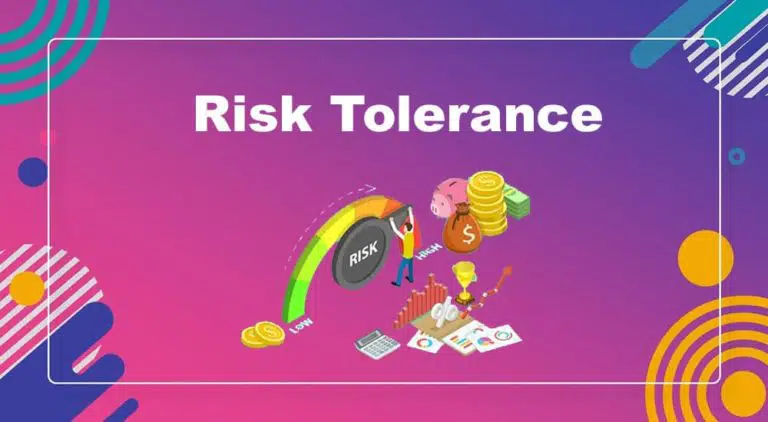
Risk Tolerance: Definition, Meaning & Examples
Definition: Risk tolerance defines how much risk an individual or organization can withstand. It is the range of specified results. A high tolerance means the organization is willing to take greater risks, and low tolerance means they are unwilling to take high risks. Risk tolerance shows the risk attitude of stakeholders in measurable units. It indicates how sensitive…

Drexler/Sibbet Team Performance Model
Drexler-Sibbet Team Performance Model is a Team Performance Model to guides a team to work collaboratively and achieve success. It helps teams organize their work and improve the performance. This model explains group dynamics and prepares teams for changes. It builds a resilient and flexible team to handle any situation effectively. What is the Drexler/Sibbet…
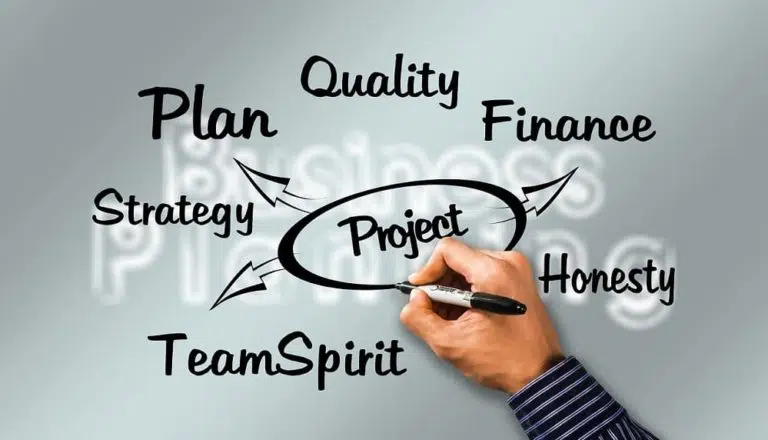
What is a Project? Definition, Types & Examples
On my blog, I have written various posts connected to projects and project management; however, I have not written anything specifically on projects and project management, programs and program management, or portfolios and portfolio management. I am currently working on developing blog pieces about these subjects, the first of which will be titled “What is a Project, Its…
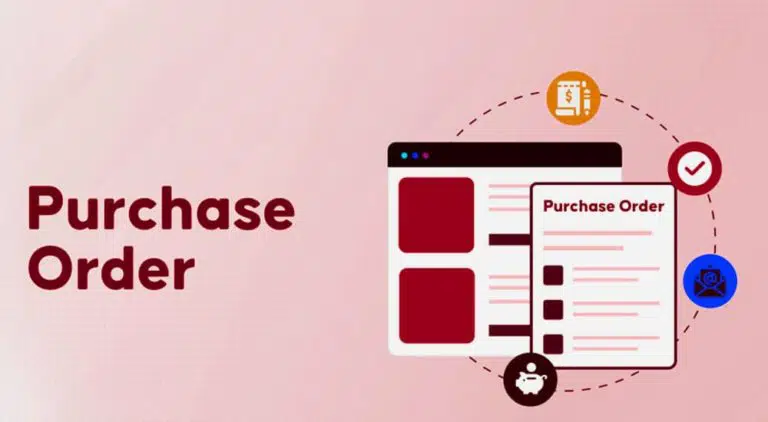
Purchase Order (PO): Definition, Templates, Types & Example
A Purchase Order (PO) is a crucial document in procurement management. Project managers use purchase orders to buy materials for their projects, and organizations buy materials and consumables for their operations. A better understanding of this document is essential for you if you manage projects which require frequent purchasing. Today’s blog post will discuss this…

Five Scrum Events or Ceremonies for Beginners
In Agile methodology, collaboration and iterative product development are key to success. Implementing Five Scrum Events within this framework drives teams toward their product goals. These events, collectively known as the “Five Scrum Events,” provide a framework to plan, synchronize, inspect, adapt, and continuously improve the product. Each event has a distinct purpose and brings…
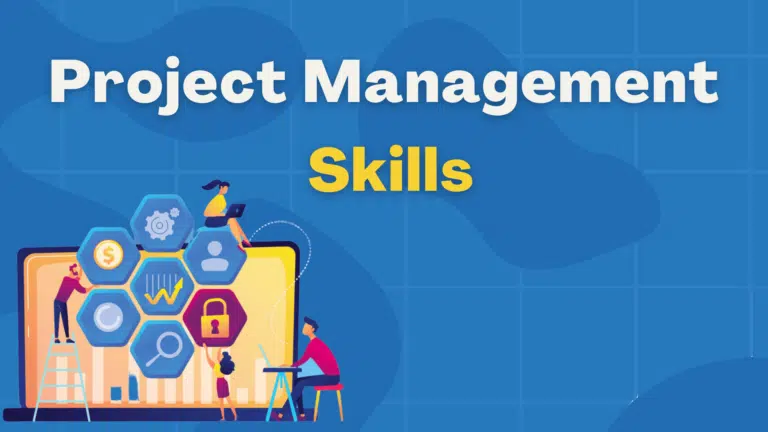
Top 29 Project Management Skills (Soft and Hard Skills Included)
The project management environment is dynamic, and project managers require many skills to successfully run and complete the project. Key project management positions include project manager, program manager, and portfolio manager. Project managers are responsible for planning, executing, monitoring & controlling, and closing the project. Program managers are responsible for managing similar projects, and portfolio…
Leave a Reply Cancel reply
Your email address will not be published. Required fields are marked *
Organizational Structure
What is a Responsibility Assignment Matrix
Last updated: Feb 15, 2023
Table of contents
What is a RAM matrix used for?
How to make a ram or raci chart.
Learn what a Responsibility Assignment Matrix is and how to use one to make all your upcoming projects run smoothly.

A Responsibility Assignment Matrix (RAM), sometimes known as a RACI chart, is a tool used in project management to keep track of all responsibilities assigned to cross-functional teams on a specific task or assignment.
It’s known as a RACI chart because its acronym names the four key roles displayed in the matrix:
- Responsible: Who is the person responsible for completing a task or making a decision?
- Accountable: Who is accountable for the completion of the project overall and will sign off on deliverables and decisions?
- Consulted: Who needs to be consulted to provide input on a particular task or item?
- Informed: Who needs to be kept informed of project progress or completion?
A typical RAM template looks like this:
The RAM matrix is used to document every task, item and decision involved in a project completion process. By keeping everything logged all in one place, a RAM matrix is an invaluable tool to any project manager or company leader for a few reasons.
- Defines clear roles and responsibilities
There is nothing worse than a project being slowed down or stalled because of confusion over who was supposed to do what. In a RAM, every person or team involved can check to see which task or item.
- Streamlines communication
Sometimes explaining directions in person or over a workplace communication tool can get confusing or be interpreted the wrong way. Even worse, one instance of miscommunication can tank an entire project or jeopardize a relationship with a client.
With a RAM, project managers don’t have to waste time directing questions to the responsible stakeholder in charge of making a decision. The chart informs everyone involved exactly who they can go to for answers, cutting out repetitive conversations and notifying the right people at the right time.
- Distributes workloads evenly
No one ever wants to be the one in the group project that has to do everything. Team members with a higher workload are at a greater risk for burnout. A great benefit of a RAM is that everyone can see how the workload for a certain project is distributed. It’s also a great way to be transparent within workflows.
Don’t let the random letters confuse you. Building a RACI chart is surprisingly simple. It can also easily be tweaked to fit your organization and your particular project. According to the work management platform Wrike , here are four steps to follow when building a responsibility assignment matrix:
- Identify all project roles
Start out with a list of everyone involved in a project, including every team, team member, manager and stakeholder.
- Identify all project tasks
Then make a list of all the tasks and items needed to get a project done. These can include deliverables, activities, milestones and decisions.
- Create a chart with a column for each role and a row for each task
In a spreadsheet—or any other tool you’d like—create a simple table by listing each person or role in the columns and each task or deliverable in the rows.
To get the most out of your RACI chart, try to make the roles as personal as possible. For example, instead of naming a role “technical lead,” try to use names, like “Jack.” This will give every person involved a sense of ownership, while also streamlining communication even further.
- Assign “R,” “A,” “C” or “I” to each person involved
Once you have written out the names of each person and task, now comes the important part of assigning RACI to each person involved. Identify who is responsible, who is accountable, who needs to be consulted and who needs to be informed for every task in the project. A role can have more than one letter, but simplify it as much as you can. Bonus step: Add a color to each letter to make the roles stand out even more.
That’s it! You now have made a successful RACI chart. Review with your team and all stakeholders before you initiate a plan, and you are officially on your way to more effective project management.
Create your own free org chart today!
Show off your great team with a public org chart. Build a culture of recognition, get more exposure, attract new customers, and highlight existing talent to attract more great talent. Click here to get started for free today.

The ORG helps you hire great candidates
Free to use – try today
Which Org Structure Fits You?
Matrix organizational structure, flat organizational structure, functional organizational structure.

The Defense Acquisition Encyclopedia
Program Management
A Responsibility Assignment Matrix (RAM) describes the participation of various organizations, people, and their roles in completing tasks or deliverables for a project. The Program Manager (PM) uses it to clarify roles and responsibilities in a cross-functional team , projects, and processes. A RAM has four primary assignments: Responsible , Accountable , Consulted , and Informed (also called a RACI matrix).
Definition: A Responsibility Assignment Matrix (RAM) describes the role and responsibilities of various people and/or organizations in completing specific tasks for a project.
Responsible, Accountable, Consulted, and Informed (RACI) Matrix
A RAM is called a Responsible, Accountable, Consulted, and Informed (RACI) matrix. The PMBOK Guide 4th Edition defines RACI as a RAM that illustrates the connections between work packages or activities and project team members. In fundamental terms, RAM refers to the framework in place to distribute duties to individuals where, in a RACI, each team member is assigned a role based on one of the four roles. On larger projects, RAMs can be developed at various levels.
- Responsible (R): Those who do the work to achieve the task. There is typically one role with a participation type of responsibility, although others can be delegated to assist in the work required.
- Accountable (A): The one ultimately accountable for the correct and thorough completion of the deliverable or task, and the one to whom Responsible is accountable. In other words, an Accountable must sign off (Approve) on work that Responsible provides. There must be only one Accountable specified for each task or deliverable.
- Consulted (C): Those whose opinions are sought and with whom there is two-way communication.
- Informed (I): Those who are kept up-to-date on progress, often only on completion of the task or deliverable, and with whom there is just one-way communication.
Benefit of Utilizing a Responsibility Assignment Matrix (RAM)
The RAM holds substantial advantages for project managers by clarifying the importance of their processes within the team. It fosters a sense of collective contribution among all employees, eliminating the sense of isolation. This project management technique, the RAM, empowers every team member to grasp the broader context of their work. Instead of simply instructing an administrative assistant to collect phone numbers without context, you can refer them to this valuable resource. By using the RAM, employees become more engaged in achieving positive results as they comprehend the alignment of their contributions with the company’s overall operations.
Responsibility Assignment Matrix (RAM) Goal in Project Management
A RAM is used in project management as a communication tool to ensure that work tasks are designated as a responsible agent. A RAM can define what a project team is responsible for within each component of the Work Breakdown Structure (WBS) . It could also be used within a working group to designate roles, responsibilities, and levels of authority for specific activities. The matrix format shows all activities associated with one person and all people associated with one activity. This ensures that only one person is accountable for any task to avoid confusion.
Responsibility Assignment Matrix (RAM) Tutorial
Responsibility Assignment Matrix (RAM) Standard Format
A RAM is displayed as a chart that illustrates the interaction between work packages that need to be done and project team members. Typically, the list of objectives is on the left-hand column with the project team member names across the top. Each work package will be assigned to the appropriate project team member. The chart aids in communication among the project team members.
No one should typically have more than one degree of responsibility for any given deliverable or activity group in the RAM chart. To simplify things, we’ve assigned each participant in this scenario a certain amount of commitment. However, there is frequently white space when you create a genuine model for more than four people. In some situations, it’s okay to have someone with secondary responsibility but not primary.
Responsibility Assignment Matrix (RAM) Template
Template: responsibility assignment matrix (ram) (excel), 6 steps to developing a responsibility assignment matrix (ram).
Below is a list of the 6 (six) most common steps in developing a Responsibility Assignment Matrix (RAM).
- Step 1: List all project tasks and deliverables
- Step 2: Identify all project stakeholders
- Step 3: Determine the responsibility and accountability level for each task and deliverable
- Step 4: Assign stakeholders to each task
- Step 5: Assign overall stakeholder
- Step 6: Ensure all stakeholder know their responsibility
Developing Responsibility Assignment Matrix (RAM) Matrix Best Practices
Below is a list of best practice topics that can help Program Managers effectively build and use a Responsibility Assignment Matrix.
- One stakeholder is in charge per task.
- The least amount of people accountable, the better.
- Be Efficient with Meetings.
- Constant Communication.
- Stakeholders agree on final RAM
Responsibility Assignment Matrix (RAM) Lessons Learned
A Responsibility Assignment Matrix (RAM) is a tool used in project management to identify and clarify the roles and responsibilities of the different people or groups working on a project. The goal of making a RAM is to make sure that all tasks are done and that responsibilities don’t overlap or get missed. Here are some things you can learn to make sure your RAM is built right:
- Define the project’s goals and scope in detail: Before making a RAM, it’s important to have a clear idea of the project’s goals and scope. This will help make sure that all necessary tasks are included and that the responsibilities are in line with the overall project goals.
- Find out who all the stakeholders are and what their roles are: A RAM should have a list of all the people or groups involved in the project, such as internal team members, external partners, and customers. There should be roles and responsibilities for each stakeholder.
- Give each stakeholder specific tasks and responsibilities: Instead of giving each stakeholder a general role, it is important to give them specific tasks and responsibilities. This will help make sure that no one’s responsibilities get mixed up or left out.
- Make sure that all stakeholders know about and understand the RAM: It is important to make sure that all stakeholders know about and understand the RAM. This can be done by having regular meetings and giving updates, as well as by putting the RAM in writing.
- Review and update the RAM often: As the project moves forward, it may be necessary to review and update the RAM. This can help make sure that the RAM stays correct and helps the project reach its goals.
Difference Between a Responsibility Assignment Matrix (RMA) and a Responsible, Accountable, Consulted, and Informed (RACI) Matrix
The PMBOK Guide 4th Edition defines RACI as a RAM that is used to illustrate the connections between work packages in a Work Breakdown Structure (WBS) and project team members. The difference between a RAM matrix and RACI matrix is:
- A Responsibility Assignment Matrix (RAM) describes the participation of various organizations, people, and their roles in completing tasks or deliverables in a Work Break Down Structure (WBS) for a project.
- A Responsible, Accountable, Consulted, and Informed (RACI) matrix is used on projects where multiple groups of people as assigned a task. It helps on larger projects with a lot of people and organizations. It also helps with outside stakeholders and their responsibilities on a project.
- A RACI can have multiple RAM within it.
AcqLinks and References:
- Template: Responsibility Assignment Matrix (RAM) Template (Word)
- Template: Responsibility Assignment Matrix (RAM) Template (Excel)
Updated: 1/11/2024
Leave a Reply
You must be logged in to post a comment.

The Project Managers Guide to Microsoft Project 2019 pp 207–264 Cite as
Managing Project Resources and Assignments
- Gus Cicala 2
- First Online: 30 April 2020
1344 Accesses
At the end of the chapter, the reader should be able to
This is a preview of subscription content, log in via an institution .
Buying options
- Available as PDF
- Read on any device
- Instant download
- Own it forever
- Available as EPUB and PDF
- Compact, lightweight edition
- Dispatched in 3 to 5 business days
- Free shipping worldwide - see info
Tax calculation will be finalised at checkout
Purchases are for personal use only
Author information
Authors and affiliations.
Wilmington, DE, USA
You can also search for this author in PubMed Google Scholar
Rights and permissions
Reprints and permissions
Copyright information
© 2020 Augustus Cicala Jr
About this chapter
Cite this chapter.
Cicala, G. (2020). Managing Project Resources and Assignments. In: The Project Managers Guide to Microsoft Project 2019 . Apress, Berkeley, CA. https://doi.org/10.1007/978-1-4842-5635-0_8
Download citation
DOI : https://doi.org/10.1007/978-1-4842-5635-0_8
Published : 30 April 2020
Publisher Name : Apress, Berkeley, CA
Print ISBN : 978-1-4842-5637-4
Online ISBN : 978-1-4842-5635-0
eBook Packages : Professional and Applied Computing Apress Access Books Professional and Applied Computing (R0)
Share this chapter
Anyone you share the following link with will be able to read this content:
Sorry, a shareable link is not currently available for this article.
Provided by the Springer Nature SharedIt content-sharing initiative
- Publish with us
Policies and ethics
- Find a journal
- Track your research

IMAGES
VIDEO
COMMENTS
The responsibility assignment matrix (RAM) is a form of project management that encourages everyone to understand every step of the project. Looking at the chart involves all parties and ...
A resource assignment matrix or a RAM you might see it referred to on the PMP exam, shows the project resources assigned to each work package. Each thing that we're working on and who is working on it. It is used to illustrate the connections between work packages or activities and the project team members. An example of a resource assignment ...
Draft the responsibility assignment matrix using a table with the project tasks listed on the left-hand column. Across the top add the name of everyone in the project. Where the tasks meet the project team member, assign whether they're responsible, accountable, consulted or informed. When completed, share the responsibility assignment matrix ...
RACI is a project management acronym for the different responsibility types within a project: Responsible, Accountable, Consulted, and Informed. The RACI matrix clarifies the roles named individuals or groups will play in the successful delivery of the project. Accurate RACI matrices can help ensure a project's success before it even begins.
What Is a RACI Chart? A RACI chart, also called a RACI matrix, is a type of responsibility assignment matrix (RAM) in project management. In practice, it's a simple spreadsheet or table that ...
Introduction to Responsibility Assignment Matrix (RAM) Project management is a complex process that involves multiple stakeholders, tasks, and resources. To ensure the success of a project, it is crucial to assign clear roles and responsibilities to team members and accurately define their tasks. One tool that can help project managers achieve ...
Key Takeaway: A Responsibility Assignment Matrix (RAM) is a useful tool for project managers to assign tasks and responsibilities to team members. It can help improve communication, increase accountability, track progress more accurately and reduce risk. There are two main types of RAMs: Functional (F-RAM) and Projectized (P-RAM), each with ...
A RACI chart—also known as a responsibility assignment matrix—is a diagram used in project management to define team roles across 4 categories: Responsible, Accountable, Consulted, and Informed. It helps clarify who does the work, who calls the shots, whose opinion matters, and who needs to stay in the loop for each task, milestone, or ...
In business and project management, a responsibility assignment matrix (RAM), also known as RACI matrix (/ ˈ r eɪ s i /) or linear responsibility chart (LRC), is a model that describes the participation by various roles in completing tasks or deliverables for a project or business process.RACI is an acronym derived from the four key responsibilities most typically used: responsible ...
A RACI chart (sometimes called a Responsibility Assignment Matrix) is a way to identify your project teams' roles and responsibilities for any task, milestone, or project deliverable. By following the RACI acronym, you can clarify responsibility and reduce confusion. RACI stands for: Responsible. This person is directly in charge of the work.
A resource plan is a key tenet of successful project management. Read this guide and learn how to assign, track and balance resources. Skip to Content ... Responsibility Assignment Matrix: A responsibility assignment matrix defines resources according to various levels of responsibility for completing project tasks or for the overall project ...
This matrix clearly identifies which role each team member has agreed to take on for each of the project's main deliverables. With these assignments, you can eliminate miscommunication about who's doing what - and you can help to ensure that your project is successful. You've accessed 1 of your 2 free resources.
A resource matrix, also known as a staffing matrix or resource allocation chart, is a visual representation that maps project tasks or activities against the resources required to complete them. It provides an overview of the project's resource needs and helps in identifying potential bottlenecks or imbalances in resource allocation. The ...
A RACI matrix—often called a RACI chart or responsibility assignment matrix (RAM)—is a project management tool that captures the roles and responsibilities of project stakeholders. Team members can see who does what at a glance, clarifying different roles across complex projects. The acronym RACI stands for:
This video describes the Resource Assignment Matrix, from the Project Management Body of Knowledge. The most common RAM is a RACI - who is Responsible, Acco...
5) Developing Responsibility Assignment Matrix (RAM) best practices . 6) Conclusion . What is a Responsibility Assignment Matrix in Project Management? A Responsibility Assignment Matrix (RAM) in project management is a tool that outlines and defines the roles and responsibilities of individuals or groups involved in a project.
Assigning RACI roles and responsibilities to TeamGantt tasks. Open your project, and toggle to the RACI tab. This will display all your project tasks in a list format (rows). On the right side of the matrix, you'll see a column for each person currently invited to the project with cells for each task in the project.
The responsibility assignment matrix, also known as RAM, is a helpful tool used in project management to identify and clarify the roles and responsibilities of each team member. It ensures that every team member understands their duties and how they fit into the project plan. Using RAM in project management helps define roles and ...
A responsibility assignment matrix (RAM) in project management is a key document that distinguishes stakeholders' roles and responsibilities. The RACI chart is the most popular example of a RAM that clarifies stakeholders' roles and defines their involvement. RACI stands for Responsible, Accountable, Consulted, and Informed.
Credit: track5/Getty Images. A Responsibility Assignment Matrix (RAM), sometimes known as a RACI chart, is a tool used in project management to keep track of all responsibilities assigned to cross-functional teams on a specific task or assignment. It's known as a RACI chart because its acronym names the four key roles displayed in the matrix:
A Responsibility Assignment Matrix (RAM) is a tool used in project management to identify and clarify the roles and responsibilities of the different people or groups working on a project. The goal of making a RAM is to make sure that all tasks are done and that responsibilities don't overlap or get missed.
The Responsibility Assignment Matrix, or RAM, is one of the fundamental charts or matrices used on an ANSI/EIA-748 project. It articulates the translational point from where detail cost, schedule and technical performance data is summed from and reported to internal and Government agencies. Additionally, this is the point at which Control ...
The assignment units value indicates the allocation of a resource to a particular task assignment. A specific resource can work full time (100%) on one task or half time (50%) on two tasks and so on before Microsoft Project flags that resource as over-allocated. You can also specify assignment units for material resources to indicate the ...